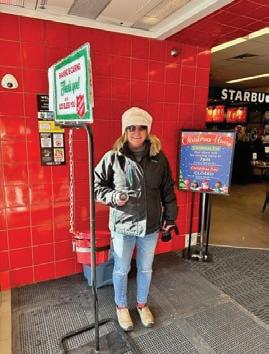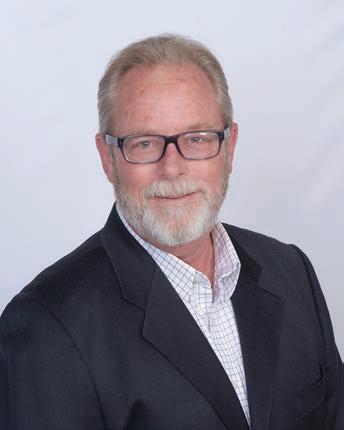Our in-depth look at the housing crisis











 BY NINA JOSS AND HALEY LENA NJOSS@COLORADOCOMMUNITYMEDIA.COM;
BY NINA JOSS AND HALEY LENA NJOSS@COLORADOCOMMUNITYMEDIA.COM;

A few years ago, Aurora Warms the Night, an Aurora-based nonpro t serving people who need housing, ran into a challenge when assisting its Black clients in applying for apartments. When the applicants visited properties, landlords denied their applications. is happened over and over again.
So the team decided to take a di erent approach, sending in White volunteers to check out the apartments rst.
“I would send one of our employees or people that were White to look at the apartment — to get the pricing, get everything, to













e ideas on Evergreen Park & Recreation District programs and facilities in the next ve years are as diverse as the community members who propose them.
About 30 people attending two virtual discovery sessions on Jan. 19 said the district should provide more indoor sports space — considered the No. 1 need by some — plus an indoor ice rink, a third rec center on the south end of Evergreen, a parking garage at the Evergreen Lake House, an indoor walking track, more indoor swimming, a better trail system and more.
ey asked for a wider variety of classes for all age groups o ered at more times, more concerts, better access for teens and more during the sessions that are the rst step in the rec district’s strategic-planning process.
Some also understood that the district needed to take care of the facilities it has rst, and one person
District o cials ask community what the district needs — and the answers are wide-ranging
If you’ve paid even just a little bit of attention to the news industry in the past decade, you know that it’s struggling. What you may not know is that community newspapers nationwide are closing at the rate of two per week.
e work of our journalists continues to be so critical for our society. We’re dedicated to keeping your city councils or school boards accountable and informing you about businesses and groups that
make your community the great place where you have decided to live.
But the fact of the matter is, the materials that it takes to get a newspaper to your front door – the newsprint, the ink, the transportation fuel – have skyrocketed in cost.
So while it’s not in our nature to make essential news less a ordable, we’ve come to the point where we must raise our prices. Beginning March 1, the price of a subscription to any of our paid publications and for all-access digital will be $85 per
year. (We will still o er a discount for readers over age 65.)
At less than $2 a week, we believe that’s still a reasonable price to pay for news you often can’t nd anywhere else.
If you’re not interested in a subscription, consider a contribution to bit.ly/give2CCM, or at the QR code to the right.



Local news is a public good. Raising these prices is how we’ll do even more for our communities in 2023. I am grateful for your support.

Sixteen elementary schools will be closing after this school year due to a vote by the Je erson County Board of Education in November. With their closing, the future use of the school buildings is called into question.
Included in that November vote was a resolution from the Board
to create a community-involved process for giving recommendations on decisions involving the use of these buildings, according to Chief of Strategy and Communications for the District Lisa Relou. Part of that process is creating an advisory committee that includes District sta as well as additional speci c ad hoc members based on the location of the building being considered, Relou said in a Board study session earlier this month.
According to Relou, there will be a “step-by-step process including value assessment, engagement with local municipalities and special districts, proposal collection, legal review and community engagement, all in an e ort to make the best determination possible as to the future
of the property.”

e Board is the only body capable of declaring a building to be surplus, and therefore able to be sold by the District. Usage proposals from outside organizations are expected, and the committee — which will be decided upon by Feb. 1 — will draft a rubric to guide decision-making on these proposals by Feb. 21.
“ is rst process, we have this property, we’ve talked with the city, and now we’re going to have a public information session,” Relou said. “We might have an open house where it’s open most of the day where people can come in and see the property, and then we host a meeting where we give more information. And when we really open this, we’re going to collect the intent
to propose — just getting a sense of what people might want to do in these buildings.”
e next step after creating a rubric for these proposals will be March 1, when the Board studies the rst round of properties that might be considered as surplus. Next would be March 9, when the Board votes on that round of properties.
“We’re in the process of scheduling, reaching out to all our option schools to see what their needs are or desires might be, so that we are certain that we wouldn’t push things through the surplus process without rst understanding if those particular things are of interest to our internal folks,” Relou said.

Starting a Family? Growing a Family? Growing Old? Staying Young? Getting Married? Adopting?
Have any of the above been a concern of yours over the past few years? Let us at Davis Schilken, PC help put your mind at ease with our Love and Planning workshop. We can help give you a quick rundown on what type of things you need to consider with your Estate Plans as your family life changes. Don’t let circumstances cause worry. We will cover things like asset protection, marriage, divorce, blended families, and more.
Remember, there is always a solution – let us at Davis Schilken help you find a solution.

Join us for one of our Love and Planning Seminars!
When: Wednesday, February 8th 8:00am – 9:30am

Where: DTC Office
7887 E. Belleview Ave., Suite 820 Denver, CO80111
*Coffee and Bagels will be provided
When: Wednesday, February 22nd 11:30am – 1:00pm
Where: Denver West Office 1658 Cole Blvd., Bldg. 6, Suite200 Lakewood, CO 80401

*Sandwiches will be provided
Please RSVP to Sherice Ritthaler at saritthaler@dslawcolorado.com or call 303-670-9855
Are your assets protected? Make sure you are safe from financial exploitation
We give families peace of mind by protecting their legacy
The future use of the 16 elementary school buildings being closed is still to be decided
to continue to support our community.

If you are looking for a great non-profit organization to donate to and one that keeps the funds they receive right here to help our local community, then please consider donating to your Conifer Salvation Army. Please reach out to Jacqueline Neal at 303-919-2923 or email: conifersalvationarmy@gmail.com or you can also mail a check to our PO Box 262, Conifer CO 80433. We are also looking for volunteers for our local Conifer unit, if you are looking to volunteer, please think about joining our team! A special thank you to our partners, King Soopers in Aspen Park, Citywide Banks in Conifer, Aspen Park-Ace Hardware, Staples in Conifer, we are so appreciative of your continued partnership and commitment to our community!


































Thank you again to our wonderful community.









Wishing you all the best in 2023 and a happy, healthy, and blessed New Year!














Pedestrian safety and curbing excessive noise are two areas the Morrison trustees want to continue focusing on, especially since those issues were brought up numerous times in a survey of town residents and businesses.
At a meeting to discuss the survey results on Jan. 18, trustees decided to ask Police Chief Bill Vinelli to create a tra c safety and noise enforcement comprehensive plan. ey also asked for data on the locations where Morrison police are writing speeding tickets.
“I feel the chief can really make an impact for us,” Mayor Chris Wolfe said. “I think we need more (speeding) enforcement in town where we live, especially on Highway 8.”
Trustees also suggested that speed enforcement should be more prevalent on Highway 74 through downtown and Highway 93 because slower vehicles will help pedestrians feel safer walking along town roads.
“Pedestrian safety ties into tra c enforcement,” Trustee Paul Sutton said. “We need to get people to slow down, and we need to encourage the (police) chief to do tra c enforcement to slow down cars.”
Morrison o cials sent a survey to residents and businesses within the approximately 2-square-mile town limits. Fifty-four community members and eight business owners responded. e survey asked wideranging questions about what the community liked and disliked about the town, with many respondents saying they enjoyed living in Morrison.
However, when asked what was the biggest challenge facing Morrison today, three speci cally mentioned speeding and pedestrian safety, while eight said quality of life would be improved by investing in pedestrian safety through trails and sidewalks, and reducing tra c speed.

Trustees agreed that the town was addressing many pedestrian safety concerns and wanted to communicate that to residents, especially since it was a hot-button topic for many. ey plan to put information in the Hogback, the town’s newsletter.


To help with pedestrian safety, the town is planning to build a trail
along Highway 8 from Canyon Vista Drive to Red Rocks Vista Drive, hoping to eventually create a path to make the Morrison Natural History Museum more accessible to pedestrians.
Morrison also will be installing ashing crosswalk beacons, one on Highway 8 at Red Rocks Vista Drive and one on the west end of town by the Philips 66 gas station.
It appears the town will not be purchasing a speed-enforcement van as it had hoped because it is too expensive, and ticket revenue would not pay for it. However, town ocials continue to look at that option and others.
Curbing excessive

Trustees said enforcing the noise ordinance can be di cult, but it was a quality-of-life issue for some residents.
“It’s a through-town thing,” Wolfe said. “We can look at the warnings being issued and see what (Vinelli) is going to propose to add to enforcement.”


In the community survey, of the 54 community respondents, 23 said noise from tra c was a moderate or major problem. Of the respondents, 29 said the town should increase enforcement of the noise ordinance by police ticketing more violators, and 28 said the town should consider acquiring noise-detection equipment so it could issue more citations.

Sutton said the survey showed that the town wasn’t xing the problem.
“We can’t continue to kick the can down the road,” he added.

In past years, the town had electronic signs along Bear Creek Avenue in the downtown area in the summer months to remind motorists of the noise ordinance.
Trustee Katie Gill said maybe the town could tie enforcement to equipment on motorcycles and vehicles rather than using decibel meters.
“We have a lot of people who live in places during the summer where they can’t have a conversation on the deck or in the yard because it’s so loud,” she said. “We need to have some degree of enforcement.”






Several metro Denver law enforcement agencies are seeking help identifying a suspect who they believe robbed four banks earlier this month.
e morning of Jan. 9, a suspect robbed the Chase Bank at 7605 W. 88th Ave. in Westminster. e following morning, the same person is suspected of robbing three more banks, including the First Bank at 8901 E. Hampden Ave. in Denver and US Bank at 8441 W. Bowles Ave. and First Bank at 6701 S. Wadsworth Blvd. in unincorporated Je erson County.
An FBI crime alert described the suspect as a white male in his 20s between 5-foot-6 and 5-foot-10 tall. He has a slender build, dark hair, brown eyes, “stubble” facial hair and black eyeglasses with a thick frame,



according to the alert.








e suspect approached the teller, made a verbal demand for money, threatened the teller and then ed the bank, the alert said.








e suspect did not display a weapon, according to a Facebook post from the Je erson County Sheri ’s O ce.



Images of the suspect show him wearing di erent baseball caps and jackets or hoodies during robberies.

e FBI’s Rocky Mountain Safe Streets Task Force and Metro Denver Crime Stoppers are working with local police agencies on the case. e FBI is involved because the Federal Deposit Insurance Corp., which insures deposits, is considered a victim, said FBI Denver spokesperson Vikki Migoya.




Anyone with information on the suspect is encouraged to call Metro Denver Crime Stoppers at (720) 913-7867, 24-hour anonymous tip line. Callers could earn up to $2,000 for information that helps solve the crimes.






The Evergreen Park & Recreation District will continue hosting discovery sessions to get the community’s input on programs and facilities the district should consider in the next three to five years.
The sessions will be:
• 6 p.m. Wednesday, Jan. 25, at Wulf Rec Center to discuss parks and outdoor recreation;

• 6 p.m. Thursday, Jan. 26, at Buchanan Park Rec Center to discuss the rec centers and indoor programs;
• 6 p.m. Tuesday, Jan. 31, at Evergreen Lake House to discuss special topics such as youth sports, aquatics, dog park, pickleball, etc.;
• 6 p.m. Thursday, Feb. 2, at Buchanan Park Rec Center to discuss serving the whole community.


suggested that if the district wanted to expand facilities, it should consider purchasing and retro tting existing vacant buildings within the district rather than building something new.
e two two-hour sessions are the rst of several planned in the next two weeks. Most of those meetings, which will be in person, cover speci c topics such as programs, facilities and special populations. e rec district is interested in all views about what the rec district should or should not be.
By July, the EPRD board hopes to
have a completed plan with a list of activities and facilities, their costs and what it can a ord. e board also will decide whether the ask voters in November for a bond to pay for some of the facilities.
A community member at one of the Jan. 19 meetings mentioned a bond that will be paid o in 2025.

e board could ask voters to continue paying that money to the rec district for additional facilities.
Chris Dropinski, senior manager with BerryDunn, the consultant hired to facilitate the strategic-planning process, said at the meetings
that no decisions had been made, and EPRD o cials were gathering information on what the community wanted the rec district’s focus to be.
In addition to the discovery sessions, the district will conduct a survey and take online comments, plus those in the district’s two rec centers can leave comments there.
“ ere will be competing priorities and limited resources,” Becky Dunlap with BerryDunn said. “We want to be visionary but realistic. ere needs to be a balance between new programs and facilities while also maintaining what we have. We will
need community support to move projects forward.”



O cials said while they will consider all of the comments they receive, they will not be able to provide everything the community wants.
Attendees suggested that EPRD make decisions based on what facilities and programs would bring the most bene t to the most people, though revenue should not necessarily be the deciding factor. ey suggested looking at alternative funding sources to help pay for some programs and facilities.
Madison & Co. Properties takes great pleasure in introducing Mark Aalund (pronounced ‘Holland’ without the ‘H’) to our Evergreen o ce. Mark grew up in Chicago, vacationed in Colorado as a kid, and moved to Evergreen with his family 28 years ago. Real estate has been in his blood since high school when his mom & step-dad were Realtors & home builders, and he worked odd jobs for them.
Mark loves nding joy in listening to his clients describe their dream home and then helping them discover and purchase their perfect home in the foothills. Each home is a journey and adventure, and he enjoys being the guide.






With the last name like Aalund, he was always rst to get called on in school. ink of Mark as the rst person to call when it’s time to buy or sell your foothills home! Reach him at Mark@ MadisonProps.com or 303-518-9593.
enjoy an evening of whimsical food, drinks, fun, auctions, and dancing to the music of tunisia.





 BY ANDREW FRAIELI AFRAIELI@COLORADOCOMMUNITYMEDIA.COM
BY ANDREW FRAIELI AFRAIELI@COLORADOCOMMUNITYMEDIA.COM





is year’s rst rabid animal for the entire state was found in Je erson County, in Morrison near West Belleview and Quincy Avenues. Jeffco Public Health announced that a skunk tested positive for rabies from an interaction at a private home on Jan. 2.

“While rabies cases are most frequently seen in warmer months, historically, Colorado does see some cases all year long,” Rachel Reichardt, environmental health specialist, said in a statement. “Last year in Je erson County, there were 15 animals that tested positive for rabies, including eight skunks and

seven bats.”
Rabies is transferred through the saliva of infected animals — most often bats and skunks in Colorado — if it comes in contact with a person or animal’s eyes, nose, mouth or open wounds. e virus itself a ects the nervous system and is considered fatal if not treated immediately, according to JCPH.
As precautions, the JCPH suggests vaccinating pets and livestock against the virus, avoiding contact with wild animals — especially any acting unusually, teaching children to stay away from wild animals, strays or dead animals and if a person is bitten, to wash with soap and water and immediately seek medical attention.

 BY OLIVIA JEWELL LOVE OLOVE@COLORADOCOMMUNITYMEDIA.COM
BY OLIVIA JEWELL LOVE OLOVE@COLORADOCOMMUNITYMEDIA.COM

Carlson Elementary School gained a new member of the sta for the spring semester, one with fur and four legs.
Elliott the therapy dog will be joining her handler, Jenny Pyler, every day at school to spend time with students and sta .
Pyler was awarded an Innovations Grant from the school district in September 2022 so she and her faithful companion could take weekly training sessions toward becoming a certi ed therapy dog.
Elliott earned her Canine Good Citizen certi cation and her erapy Dog Certi cation on Jan. 6, 2023.
Students at Carlson listened to an instructional session on how to interact with Elliott, and they learned some of the expectations for how the pup will exist in their elementary space.
Pyler explained in a letter to the parents that precautions are being taken to make sure this is a safe experience for everyone.
She noted that there will be a “dog only” space for Elliott to separate from kids who are allergic or fearful, there will be extra cleaning and vacuuming at the school, Elliott will be wiped down with anti-dander wipes to help allergies, and children will be instructed to wash their hands after
handling the dog.
Elliott has already settled into her rst few days of school, and Pyler said she’s tting right in at Carlson.
“She’s been awesome and the kids seem to be really excited when they rst come in the door,” she said.

Heather Aberg is a Licensed Clinical Social Worker and the founder of Resilience 1220. She said that therapy animals can make a huge di erence in the lives of children.
“ ey really bring down anxiety, perhaps anxiety kids don’t even realize they feel,” Aberg said.




Aberg went on to explain that a therapy animal, like Elliott, can be a non-judgemental, easy friend to talk to.
“Dialoguing to an animal is so safe,” she said.
As a professional social worker, she also said there are various physical bene ts she’s seen working with kids and therapy animals, like children sitting with the animal and working to regulate breathing.
For parents looking to continue to support their children’s mental wellness outside of the classroom, Aberg suggested things like mindfulness apps, breathing exercises and using stories to identify emotions and coping mechanisms.
“Let’s take care of our emotional health the same way we take care of our physical health,” she said.
Some people have become so alarmed by what children might read in school or in libraries that they want books they don’t like removed — immediately. e targeted books include scenes of sexual awakening, gender identity, racism or violence.
But why aren’t these alarmists focusing on a book that’s chock-full of incest, rape and gore? I’m talking, of course, about the Bible.
In Genesis 19:30-36, Lot’s daughters get him drunk in a cave and his eldest daughter has incestuous sex with him. Judges 12 tells how an angry mob surrounds a Levite and his concubine, so he appeases them by handing over his companion. What happens next to the sacri ced woman is too gory for me to describe.
Yet the Bible hasn’t been a target of book banners; moreover, some zealots attack books they’ve never read. ey just have a list.
People on the warpath about “dangerous” books started urging libraries and schools to ban books they found objectionable in 2021. at discontent bubbled to the surface during COVID-caused school shutdowns and has now erupted into a culture war.
In Idaho, where I live, book banners have targeted the state’s three largest cities of Boise, Meridian and Nampa, all in the Treasure Valley in
Smoke, mirrors
southwest Idaho.
So far, only Nampa has succumbed to the pressure. Oddly, the book tossing was started by just one woman, Tosha Sweeney, who emailed the Nampa school board to demand that it remove 24 “pornographic” books that sex offenders might use to “plan their attacks.”
To bolster her demand, she cited section 18-1515 of Idaho law, which says a person is guilty of “disseminating material harmful to minors” when they knowingly loan material with detailed sexual descriptions to underage children. e 24 books she cited were all “young adult” books, and parental consent was already required before they could be checked out.
In a city as big as Nampa, with over 100,000 residents, you’d think one person’s demands would at least require a hearing before action is taken, yet the school board removed all 24 books “forever.” As it turned out, only 23 books were taken o the shelves because one young adult book on the list had never been bought.
ere was no formal review, infu-
riating some parents who championed free speech and free choice. A month later, they joined students and teachers outside the Nampa school district o ces to protest the bans.
Laura Delaney, who owns Rediscovered Books in nearby Boise, fought back against censorship by giving away 1,500 of the banned books — donated by concerned citizens — to Nampa students and teachers.
“ ese books are written because authors are trying to gure out the world, and having them share their wisdom with people of all generations and backgrounds makes a difference,” Delaney told reporters.
en the Idaho state Legislature jumped on the controversy. Last year, House Republicans passed HB 666 to hold librarians “criminally liable” for distributing material considered “harmful to minors.”
“I would rather my 6-year-old grandson start smoking cigarettes tomorrow than get a view of this stu at the public library or anywhere else,” said Rep. Bruce Skaug, R-Nampa.
A misdemeanor conviction for disseminating harmful materials includes up to one year in jail and a $1,000 ne. Many librarians found the law terrifying; some quit their jobs or changed careers.
e “Idaho library community has lost some good people due to the con icts centered mostly around book challenges,” state librarian Stephanie Bailey-White told me. ankfully, Idaho’s Senate refused to give the anti-librarian bill a hearing. But lawmakers found another way to punish libraries: ey cut $3.8 million from this scal year’s original $11.5 million budget for the Commission for Libraries.
Idaho’s library budget cuts have now made it harder for libraries to stock new books and expand telehealth services for seniors and rural residents. Lawmakersalso defunded a statewide e-book program managed by the Idaho Commission for Libraries.
Book banning campaigns aren’t new in America, but last year the American Library Association said that library sta faced an “unprecedented number of attempts to ban books.”
e organization said the books most targeted were those about Black or LGBTQIA people. e Bible was not on anyone’s list.
Crista V. Worthy is a contributor to Writers on the Range,writersontherange.org, an independent nonpro t dedicated to spurring lively conversation about the West. She lives in Idaho.
Jack is back. Two years ago, developer Jack Buchanan came in like a wrecking ball with a proposal to raze the El Rancho park-n-ride, the Alpine Rescue Team building and the Rainbow Hills re station to construct what he envisioned as a miniature downtown Vail west of Highway 74 and north of U.S. 40.
Now, he has decided the ideal site for his proposed hotel is in the valley below U.S. 40. His new scheme called “Option B” still entails removing the re station to a site a quarter mile away, this time on a proposed 40-foot deep platform of ll dirt. He still intends to create a permanent, quarter-mile detour for the public Rainbow Hill Road.
While the plan on its face “provides” the re department a new station, it requires them to sacri ce their excellent site and facility only to gain 400 square feet in the proposed new building. Crucially, it asks the Foothills Fire Protection District, a public agency, to participate in the developer’s broader scheme in exchange for this donation.
e developer has portrayed his proposal to the county and CDOT as a public service and has explicitly requested setback relief, expedited rezoning, expedited concurrence review, and direct transfer of land (avoiding a public bid process required by state law) in return.
In addition to acquiring adjacent right-of-way, his ultimate reward is the corner property containing the park-n-ride lot—a second taxpayer-funded asset that would be sacri ced for his private bene t.
Beyond that brazen objective, he has recently submitted a contract to the FFPD that articulates a second scheme,explicitly requiring them to deceive with the expressed intention of interfering with CDOT’s property rights enshrined in the language of the deed to the parcel the re station occupies.
LINDA SHAPLEY Publisher
lshapley@coloradocommunitymedia.com
MICHAEL DE YOANNA Editor-in-Chief michael@coloradocommunitymedia.com
LINDSAY NICOLETTI Operations/ Circulation Manager lnicoletti@coloradocommunitymedia.com

DONNA REARDON Marketing Consultant dreardon@coloradocommunitymedia.com


Alternatively, Buchanan’s newly formulated “Option A” entails developing only the private land north of U.S. 40. is innovative idea entails no harm to existing public assets, nor does it embroil a special district in the morass of complications, delays and ethical ambiguity that is Option B.
e watershed decision is the FFPD’s to make. e developer has for two years sought to convince them that he alone can x their infrastructure needs, and the only way forward is his “free” o er. e people of this district are better, smarter and more resourceful than that. FFPD’s decision should be obvious, but incredibly it is still pending.
Kathryn Mauz, El Rancho and EvergreenOn Jan. 7, a man entered the Mall of America wearing a t-shirt that many found o ensive. e shirt was neon yellow and stated, “Jesus is the Only Way.” e COEXIST motto which represents peace among di erent religions was crossed out.
ere were so many complaints that mall security asked the man to remove the shirt.
e man said he was not soliciting or preaching. However, days before, he was was doing those exact two things at the mall, and got a notice of trespass as a result of his behavior. He was not allowed in the mall for 24 hours. Many people said his shirt was soliciting on its own. I am a 12 year old boy. I don’t know all the in’s and out’s of this incident. But what I do know is that man had a right under the First Amendment to wear the t-shirt. I may not believe what his t-shirt says, but I do believe that he has a right to his beliefs and a right to wear what he wants to wear.
Hudson Jones, Evergreen& Guest Commentaries
West Metro Editor kfiore@coloradocommunitymedia.com
HURLEY BROBST Community Editor dbrobst@coloradocommunitymedia.com
RUTH DANIELS Classified Sales rdaniels@coloradocommunitymedia.com
Columnist opinions are not necessarily those of the Courier.
We welcome letters to the editor. Please include your full name, address and the best number to reach you by telephone.
Email letters to kfiore@coloradocommunitymedia.com
Deadline Wed. for the following week’s paper.
Canyon Courier (USPS 88940)

A legal newspaper of general circulation in Evergreen, Colorado, Canyon Courier is published weekly on Thursday by Colorado Community Media, 27972 Meadow Dr., Ste. 320, Evergreen CO 80439. .


PERIODICAL POSTAGE PAID AT Evergreen and additional mailing o ces.
POSTMASTER: Send address change to: Canyon Courier, 750 W. Hampden Ave., Suite 225, Englewood, CO 80110










CONIFER – Neighborhood roads were snow-packed on the night of Dec. 28, and Boyfriend called Girlfriend to advise that she bunk with somebody “in the city” rather than brave the mean mountain streets. Girlfriend advised Boyfriend that while a certain lady-friend would gladly put her up for the night, the woman had three male roommates. e thought of Girlfriend slumbering in a house full of men “upset” Boyfriend so much that Girlfriend decided it best to dare the drive. She made it home without incident, which didn’t seem to please Boyfriend as much as one might think. Indeed, he was actually “more upset” that Girlfriend drove up the canyon after he told her not to, and the ensuing blizzard of bad behavior ended with Boyfriend spending the night in the county cooler.
SOUTH JEFFCO – Multiple Choice (select one): A.) Violet goes to the school to pick up her child. Ruby pulls in next to Violet, parking so close that neither of them can open their doors. Violet generously pulls out and re-parks, leaving a comfortable space between vehicles and causing Ruby to “go crazy” and start screaming at the top of her lungs. “Did I park a little too (gosh-durned) close?” Ruby hollers “I’m having a bad (dag-nabbed) day!” When Violet tries to depart with her son, Ruby backs toward her vehicle in a menacing way, which is when Violet stops and gets out of her car in hopes of inspiring Ruby to a gentler manner of expression. Instead, she only inspires Ruby to several minutes of strong language and adult themes. Ruby is ticketed for disorderly conduct. B.) Ruby goes to the school to pick up her child. She pulls in next to Violet, prompting Violet to make a hu y gesture and re-park in an irritated manner. Feeling responsible, Ruby tries to soothe Violet’s feelings with conciliatory words. “Did I park too close?” she asks. “I’m having a bad day.” Instead of accepting her tacit apology, Violet
speaks roughly to Ruby, and when Ruby tries to back out she aggressively stations her vehicle directly behind, forcing Ruby to get out and plead with Violet to move her car so she can take her precious child and depart in peace. Ruby’s appeals are rejected by Violet, who curses her roundly before driving away in a black fury. Violet is ticketed for disorderly conduct. C.) Amber rides along when Ruby goes to the school to pick up her child and pulls in a little too close to Violet. Amber keeps her head down for the next several minutes as Ruby and Violet engage in a spirited and entirely mutual hate-fest, complete with foul epithets, personal slanders and obscene directives. Amber decides not to ride along with Ruby anymore. e correct answer is D.) Deputies think Violet and Ruby both deserve tickets for disorderly conduct, but instead le a report on the incident and promise the women it will go hard for them if they ever mix it up in the school parking lot again.
EVERGREEN – Dec. 29 was just a normal day at the o ce, except he couldn’t get into the o ce. Curious as to why there was a massive pile of snow in front of the door, he found his answer in security footage. Timestamped 3:30 a.m., a former employee in a blade-equipped pickup can be clearly seen moving all of the snow in the parking lot to the least convenient place possible, a free service, seemingly, that was not at all appreciated. e complainant told JCSO deputies that the former employee has been doing “little things” to make his life di cult, but this was an annoyance of greater magnitude and he wanted it documented pending sterner counter-measures.
Sheri ’s Calls is intended as a humorous take on some of the incident call records of the Je erson County Sheri ’s O ce for the mountain communities. Names and identifying details have been changed. All individuals are innocent until proven guilty.
John passed away at home, surrounded by family, after a brief bout of heart failure. He truly lived life to his fullest with joy, passion and love. John spent his early life near Ann Arbor, MI where he created havoc with his three brothers. He attended Oberlin College where he met Kathleen, and they married in 1966 and moved to Evergreen, Colorado.
His love of ying began early with his father, and he had an almost 40 year career with United Airlines. John was a union o cer and became part of United’s management team culminating as a Fleet Captain of the 747400s. After retiring from ying, he worked for Boeing as an instructor.

John’s love of theater was shared by his wife, and they created a theater family with the Evergreen Players for 56 years. He was frequently “lead guy” for technical theater as well as their nancial steward.
John’s great passion was his family. He made special time with his grandkids and planned






15, 2023



vacations to bring family together. His close relationship with his brothers was another hallmark of his love for family.
John approached life with humor and showed genuine kindness to everyone he met. He had a love of the outdoors and was skiing black diamonds just last month. He and Kathleen often hiked in the Mountains including some 14ers.
John is survived by his wife of 56 years Kathleen Davis, his two daughters, Jamie (Je ) Lewallen of Evergreen, and Anna (Dexter) Chow of Menlo Park, CA, his four grandkids, Gabriel Jonathan Chow, Sam Beatrice Kenney, Leon Halaki Chow and Patrick John Kenney, and his three brothers, Gary Davis of Sonoma, CA, Lee Davis, Ludlow, VT and Richard Davis, Loveland, CO.
In lieu of owers, the family kindly requests donations be made to UNICEF (https://www. unicefusa.org) or Evergreen Players (https:// evergreenplayers.org/).

July 2, 1927 - January 8, 2023







Mary Lee Flower, age 95, passed away in Pagosa Springs, CO on January 8, 2023. She was born July 2, 1927 in Fargo ND to Henry A. and Louise Lee Paulson.




In 1948 she married Lawrence Maroney Flower of Denver, CO. A graduate of the University of Colorado, Mary Lee had a successful career as a well-loved elementary school teacher in Chatsworth, CA and in Grand Junction, CO. She was a devoted wife and was mother to four children: Mary Susan


April
On Monday, January 16, 2023, Commander Stan Foxx, USN, Retired, loving husband of Patricia and father to Marc, Adam, Zachary, and Patrick, passed away at the age of 79 after a brief battle with pancreatic cancer. A celebration of life



(Flower) Hines of Somerset, CA, Lawrence Lee Flower of Lakewood, CO, David Ludlow Flower of Laramie, WY, and Ann Maroney Flower of Durango, CO. She is also survived by numerous grandchildren and greatgrandchildren.
e family will hold a private service. Charitable gifts in her honor may be made to the Betty Ford Alpine Gardens; 183 E. Gore Creek Dr. #7, Vail, CO, 81657 (www.bettyfordalpinegardens.org).
will be held on April 15, 2023 which would have been his 80th birthday. Please visit www.inmemoriamservices. com/obituary/Stan-Foxx for complete obituary and location of the celebration of life.
Apple Aire. Inc.

Todd Terry 4020 Young eld St. Wheatridge, CO 80033 www.appleaireinc.com
DM Hardwood Designs
David Marsalek
254 Holman Way, Apt. #2B Golden, CO 80401 dmhrdwd@aol.com
Newland Legal PLLC

Zachary Newland 32186 Castle Court Evergreen, CO 80439 www.newlandlegal.com
Conifer Ranch
Kim Thomas 12414 US Highway 285 Conifer, CO 80433 www.coniferranch.com
AlphaGraphics

George Ri el 1217 Miner’s Alley Golden, CO 80401 http://US636.alphagraphics.com
Colorado Commercial Advisors
Jerry Anderson 29029 Upper Bear Creek Rd Evergreen, CO 80439 www.coloradocommericaladvisors.com
Pieces of Eight
Peggy & Kathy Nohava 3781 Evergreen Parkway Evergreen, CO 80439 www.piecesofeightco.net
Men’s Therapy Online
Marc Azoulay 1083 Aspen Drive Evergreen, CO 80439 www.marc-azoulay.com
Crystal Cowgirl
Celeste Hale 29005 Upper Bear Creek Road Evergreen, CO 80439 www.crystalcowgirlconsignment.com
Gri ths Law PC
Glory Schmidt 10375 Park Meadows Drive Lone Tree, CO 80124 www.gri thslawpc.com
Sage Consulting



Chad Zechiel/James Zechiel 28556 Evergreen Manor Drive Evergreen, CO 80439
Bob McCarroll LIV/Sotheby’s International Realty
Bob McCarroll 31955 Castle Court, 1S Evergreen, CO 80439 www.bobmccarrollrealestate.com

Join your neighbors at Chill Out Winterfest on February 4, 2023, for a day of fun.
“Mushies Cup” 10am @ Evergreen Lake. Use large in atables (we provide) and your team of two or four participants to race the members of your team around an obstacle course on the lake. Dogs stay home, people do the “mushing”.
Evergreen Amazing Race 1pm. Grab three friends, one of whom is the designated driver, and meet at the Stone House (1524 Belford Court) for the start of the crawl which includes challenges at each participating restaurant, consume a beer (consumption not required) and receive your clue to the next location. Each challenge will rack up points and the team with the highest number of points will be the winner. Ice Sculptures will be carved around town on this day with a theme of “Love is in the Air”.
Glow-Skate @ Evergreen Lake from 5-8pm. Come out to enjoy the full moon with glow items to light the way. There will be music, smores, and lots of laughter to shake us out of our winter doldrums!
PREregistration required @ evergreenchamber.org
Nancy Judge, President/CEO, Evergreen Chamber of Commerce

Brought to you by the
BY DEB HURLEY BROBST DBROBST@COLORADOCOMMUNITYMEDIA.COM
Several foothills schools are using less energy thanks to each school’s environmental-awareness club.
While some clubs have di erent names, such as the Green Team Superheroes and the Keep Conifer Green Club, the goal is the same: to help the environment. Parmalee and Wilmot elementary schools, Evergreen Middle School and Conifer High School participated in the Renew Our Schools challenge, a competition to lower energy usage with winning schools getting cash prizes for energy projects such as LED lights, window tinting, solar shades and more.
Students had ve weeks to get their schools to use less energy, and Resource Central, a Boulder-based nonpro t that operates Renew Our Schools, provided an eGauge that monitors energy use in the school building in real time. Students use that data to nd areas where their schools could be more energy efcient.
“All schools showed great participation in the competition,” said Carly Hester, program coordinator for Renew Our Schools. “ eir commitment to energy conservation and education really showed.”
She said the seven schools in Jefferson County that participated in the Renew Our Schools challenge were divided into two groups, and Parmalee and Conifer High School each won second place in their groups.
Some clubs use challenges among classrooms to lower energy consumption including turning o
overhead lights and reducing the amount of energy used by pluggedin devices.
Parmalee Elementary School’s Green Team Superheroes member Amelia Bega explained that it was important to help the school reduce energy to save money and to help the planet.
e Superheroes said it was easy to do – turning o school lights when they weren’t necessary and unplugging anything that wasn’t in use, especially overnight.
“It’s important to stay mindful to reduce energy use,” Parmalee Superhero Sienna Winters said. “If we reduce energy, it helps with the bills and how much energy we use.”
Parmalee’s Superheroes went to each classroom to take an energy audit, using instruments to measure the amount of energy being used. Led by adviser Lisa Dewil, the superheroes are enthusiastic about their quest to reduce energy.
Conifer High School has a Keep Conifer Green Club that meets regularly to work on improving the school’s environmental footprint, including the Renew Our Schools challenge.
Wilmot’s Green Team is very active, operating recycling and composting campaigns, in addition to lowering the school’s energy consumption.
Evergreen Middle School’s team, which is small but mighty according to adviser Julia Fliss, took part in Climate Action Day to get ideas on how to make the school more green.
“Climate education is a way to empower students,” Fliss said. “ is is a tool that helps them do something to help the planet.”

















 BY DEB HURLEY BROBST AND PETER JEANS DBROBST@COLORADOCOMMUNITYMEDIA.COM
BY DEB HURLEY BROBST AND PETER JEANS DBROBST@COLORADOCOMMUNITYMEDIA.COM


















e look on Jameson Mott’s face said it all — shocked when she learned she had reached a major high school basketball milestone: 1,000 points. e 5’11” forward, a senior who has played on the Evergreen High School varsity squad all four years, said she was surprised not only at reaching the milestone on Jan. 5 but at the celebration during the game.
Mott’s 1,000th point came like so many others: After receiving a pass from senior point guard Bella Reece, she hoisted a perfectly arched shot. Nothing but net … and cue the celebration. Evergreen called timeout, the stands erupted, and the announcer let the crowd know of the accomplishment.

Mott, 17, hardly knew what to do, but her teammates did. ey swarmed her as the student section unfurled a banner that read “1,000 points.”
Evergreen’s 42-27 loss to Standley Lake that night was a little less painful thanks to Mott’s achievement.

ity, a natural talent (as a basketball player),” Evergree head coach Maddy Hornecker said. “ at’s the surface level of it, but I don’t think people know the work that has gone into that. She is probably in the gym six days a week. She usually doesn’t


body co-president, involved in clubs, is taking two advanced placement classes a semester and works parttime at Mountain Daisy. In her free time, she likes to hike and bake with
her older sister, Lily. eir specialty,
“Jameson is talented, but she also has been willing to grind and work hard in sports and in school,” dad Chad Mott said. “She has taken on
those challenges through hard work. is hasn’t come easy, and she has earned every bit of it. It’s all been through the love of the game.”
4 years as a standout
Jameson’s rare milestone was reached on the back of four stellar seasons that began as a freshman shooting guard in 2019-20 with 284 points. She followed that up with a sophomore campaign in which she tallied 209 points and was honored as First Team All-Conference.
Last year she racked up another 334 points and was selected as the 4A Je co Girls Basketball Player of the Year. is year she has more than 177 points despite being one of the most closely guarded players in the state, the focus of every opponent’s attention.
“ e downside is that when you are the main scorer, (opponents) will often double team you,” Chad said. “She has been seeing that for the last four years, so the points she scores are well earned.”

A love of basketball
Jameson said she loves basketball because she loves team sports.
“Basketball is more of a connection,” she said. “With the right team, you can accomplish so much.” ough, she added, “I do like to shoot.
“My teammates inspire me,” she continued. “If I don’t keep up with my role, I let them down. You have


to pull your weight.”

She loves her team, calling her teammates “super sweet.”
Starting at a young age
Jameson fell in love with basketball in elementary school when she tried her hand at the sport through an Evergreen Park & Recreation District program.

“My brother played,” she said, which meant she needed to try the sport for herself.




Jameson and brother Jackson Mott practiced in the Bergen Valley gymnasium where their mom, Kim
Mott, is a teacher, or the Evergreen High School gym, where Chad is a teacher, plus in the Wulf Rec Center gym.

She calls the Evergreen High School gym her home away from home. e siblings practiced nearly every day for about 90 minutes or until another sport needed the gym for practice until Jackson graduated.


Chad remembers Jameson scored 28 points as a freshman in her rst Evergreen game against Battle Mountain.
Jameson said starting in the rst game her freshman season was pretty shocking, too, since there were eight seniors on the squad.
Similar mindset to Dillon e last Evergreen player to reach 1,000 points was Claudia Dillon in 2019, and Hornecker said she wished Dillon and Jameson had the chance to play together for Evergreen.

“ ey have a lot of similarities,” Hornecker said. “ ey are both incredibly smart academically, and they are both family oriented. ey both have strong work ethics and determination. ey both know their goals for their lives and what they want to do.”

More basketball in her future
Jameson has committed to playing basketball at Gettysburg College, a liberal arts school with a solid basketball team in Pennsylvania.
“We looked at a lot of schools,” Chad said. “When we made the list of pros and cons, Gettysburg







checked all the boxes.”


Ironically, Jameson’s parents grew up in Gettysburg, and Chad’s dad was a professor at Gettysburg College for 55 years. Her parents still have cousins in the area, and Jameson will have the opportunity to connect with them during her time in college.


Jameson plans to major in marketing, hoping to have a career in women’s athletic fashion.
Compassionate, caring Kim said the family jokes that Jameson is the kindest member of the family.

“She always has a smile, always is willing to help and very caring to everyone,” Kim said. “I think those are the best qualities.”

Longtime teammate Reece said Jameson is the “consummate teammate, always looking in on her fellow players and about their mental health and their academics. She is especially good about encouraging our underclassmen teammates.”
Hornecker said Jameson has been a big help with the younger players.
“Jameson always has been somebody who takes care of the younger kids,” Hornecker said. “She has been teaching them … and has stepped up and grown into an onthe-court kind of coach.”
Chad has enjoyed watching Jameson’s basketball career and her 1,000-point achievement.
“It’s been a lot of fun for her,” Chad said of the milestone. “She’s the kind who doesn’t really come easily to the spotlight, but it’s certainly been well deserved. It’s been four years of hard work.”






e rst week of Colorado Community Media’s Long Way Home series focused on what many experts say is a housing crisis across the metro area. In short, housing is increasingly una ordable and inaccessible for Coloradans. Week two of our four-week series turns to how those issues look through the lens of race and younger residents, some whose experience of the American dream is changing..
Reporters Nina Joss and Haley Lena delve into the realities faced by would-be Black homeowners and others who nd skin color can be a factor in achieving their long-term dreams. .


Joss and Lena break down how the system can sometimes work against Black applicants. ey also uncover possible solutions, including an initiative from Realtors to provide training that averts subtle biases in the buying process.
Meanwhile, reporter Ellis Arnold asks a di cult question about metro area suburbs: why are they so White? ere’s no single answer, but some neighborhood covenants from a few decades ago

FROM PAGE 1

make sure everything was available,” said Brian Arnold, who was executive director of the group at the time ve years ago. “After that, we did the application online and sent it in without them being able to see the person.”
Once the application got approved, the team at Aurora Warms the Night would let the real estate agents see the client was Black. Arnold said this process worked almost
prove, in writing, that race was sometimes a factor in creating our communities.
Accessibility to housing isn’t only an issue of race. It’s an issue of income, as well. Many Coloradans simply can’t a ord to apply for a home, and some of them are rede ning their idea of the American dream as a result. Reporter Christy Steadman digs into this issue. When affordability, accessibility and fairness play a role, families are shifting away from the old dream in which people started a family and bought a home.
When rising home prices and in ation makes that next to impossible for many Coloradans, the American dream may shift from the idea that owning a home is the true measure of success. Still, across generations, many hold out hopes for homeownership.

Statistics, data and experts may have great information on how the market works, but it’s the people living through the crisis who matter the most.
To read all the parts of our Long Way Home series, visit https://coloradocommunitymedia. com/longwayhome/index.html.

every time and became the organization’s own way of making a dent in the discrimination that people of color may face, but nd di cult to prove.
Because many of the individuals served by the group were facing homelessness and unemployment, Arnold acknowledged that these factors could have played a role in their initial application rejections. However, when they conducted the blind application process with the same nancial information, the applications were approved. For Arnold, this con rmed race was a barrier.
“ e racism is just so out there,”
he said. “It was easy to realize it.”

Arnold’s group did not le any complaints because their main priority was getting their clients housed, and they found a way to do that. Colorado Community Media reached out to Aurora Warms the Night to see if this is still a strategy but did not get a response.

But once a Black client successfully got on a lease, Arnold said







*




even more challenges ensued if they were looking to someday own a home.
“How do we get them from renting into homeownership?” he said. “ ose barriers seem to be some of the biggest.”




For decades, homeownership rates for Black people have lagged far behind those for White people. Census data released last month shows just how wide that gap is. More than seven in 10 White Coloradans and a little more than half of Latino residents own their homes, according to the 2021 ve-year American Community Survey. Only 42% of Black Coloradans own their homes.
Although Latino homebuyers in Colorado face many of the same barriers as Black homebuyers, their





rates of homeownership have grown in recent years. For Black Coloradans, on the other hand, the numbers have remained stubbornly low.
ese trends hold across the metro area, with Adams, Je erson, Arapahoe and Douglas counties all showing higher rates of homeownership in White communities than in those of color.
e reasons for this gap are myriad, but over time, Black Coloradans have generally had less opportunity to build home equity and wealth to pass from one generation to the next. ese barriers mean many metro Denver communities lack racial and ethnic diversity. rough training and other measures, many are now trying to reverse this situation and improve access to housing for all.
In 2021, eo E.J. Wilson and his wife started looking to buy a home in Aurora. Wilson is a Black college lecturer and non ction television host.
Like many Coloradans regardless of color, Wilson and his wife did not have enough money for a down payment in today’s expensive housing market, even though they both make a good living. In Arapahoe County, the median sale price of a singlefamily home increased by $180,000 over the past ve years, according to the Colorado Association of Realtors. In other metro Denver areas,
the numbers have skyrocketed even more drastically.
While many White Americans may have bene ted from the e orts of their ancestors, particularly through inheritances, Wilson says many Black people, including him, were denied that possibility. In his eyes, that’s part of why homeownership has been so elusive.
“In what some of my elders have called the ‘illusion of inclusion,’ income is used as a metric to say that things are getting better for Black people,” Wilson said.
But, he pointed out, income is di erent from wealth. For generations, “White America was building wealth, assets and the skill set and personnel to manage that wealth,” he said.
Wilson’s older family members, on the other hand, were not o ered the same opportunities, he said.
Wilson’s grandfather was in the Army Air Forces during World War
II, a Tuskegee airman, one of a pioneering group of Black military aviators. When he returned to New York City after the war, he did not receive federally backed home loans like his White counterparts did.
“ ey basically shoveled these White vets from World War II into programs that gave them college money and programs that gave them homes in the suburbs,” Wilson said. “Imagine if my grandpa would have got the property that he would have got had he been White in New York City. How much would that be worth today?”
Many Black veterans faced issues using the programs o ered by the GI Bill. ey often could not access banks for home loans, were excluded from certain neighborhoods and faced segregationist policies. Instead of a home in the suburbs, and despite his service to his country, Wilson’s grandfather wound up in low-income housing. ere, he
raised Wilson’s father, who was not able to attend college.
“ e only physical thing that I have from (my grandfather) besides his DNA is a collection of hats … that shouldn’t have been the case,” Wilson said. “I should have more from him than his name, his genes and some hats.”
In that era, federal authorities also made color-coded maps that reected the practice of restricting access to home loans in certain areas, partly based on race. is practice is known as “redlining.” People of color were also excluded from obtaining housing through “racially restrictive covenants,” or text written into property records that was used to prevent people of certain races from purchasing certain homes.
Some exclusionary policies, which have been documented in the Denver area, left a toll that’s evident in communities of color today.
Family wealth is a good measure of that. In 2019, the median White family in the country had about $184,000 in wealth compared to just $38,000 and $23,000 for the median Hispanic and Black families, respectively. at’s according to data from the Federal Reserve Survey of Consumer Finances.

ese numbers speak to the notion of generational wealth. Generational wealth is anything of nancial value that is passed from one generation to another — including money, property, investments, valuable heirlooms or businesses.
“ ink about the wealth that was created during (the ‘40s and ‘50s) that White families have been able to
With the new year upon us, small business owners will want to look at what will help them reassess their business visions and set new goals, all to increase revenue and bring in new customers. Business resolutions will vary, just as they do in personal life, but there are top goals to consider that make good business sense. Here are eight measurements that will help refresh your business operations. Are the measurements you choose achievable, quantifiable, and have deadlines with assessments in place?
1. Update your business plan- Establish goals for you as a business owner and brand to help you achieve a clear sense of direction. Revisit those goals monthly, noting what worked and didn’t for you and your sta .
2. Refresh your marketing plan- The marketing plan, a component of the business plan, needs an update every year to see what marketing strategies were successful.
3. Advance your digital presence- Most
businesses already have a website, but keep yours updated with your latest business news.

4. Promote all year long- Don’t wait to promote and market your business; make it a regular push all year. Come up with a monthly promotion, using daily calendars to prompt ideas.
5. Personalize customer service- Be sure to personalize the entire buyer journey by o ering products and services based on your customers’ purchasing behaviors.
6. Foster a positive workplace- Establish a positive work culture by being more open to and encouraging feedback from your sta .
7. Give back- Employees often like to be part of a workplace culture that gives back to and shows gratitude to the broader community. Be sure to appreciate the community for supporting your business.
8. Be trustworthy and transparentEngage in authentic interactions with
your customers and clients to build trust and operate your business with transparency. Invite customers to interact with you online or through social media.
The Conifer Area Chamber of Commerce was founded on December 11, 1975, by local business people and has been bringing the community together ever since. Our goal is to create opportunities for our members to succeed. We actively promote our members through monthly membership meetings, after-hours mixers, educational workshops, quarterly nonprofit meetings, and community events, including Annual Chamber Awards, Elevation Celebration, and our everpopular Conifer Christmas Parade. Our mission is to encourage, develop, promote, and protect the general business interests of the area in accordance with the principles of the free enterprise system.

OUR VISION IS TO CREATE A THRIVING BUSINESS COMMUNITY THROUGH
MEANINGFUL CONNECTIONS, IGNITING GROWTH OPPORTUNITIES, AND ADVOCATING FOR A HEALTHY ECONOMIC ENVIRONMENT.
Membership with the Conifer Chamber connects you to our community, its resources, and many opportunities to grow your business. Chamber members can access exclusive programs and venues that help build their business and personal relationships, increase visibility, and generate leads.

You can contact the Conifer Area Chamber of Commerce and ask how we can help you grow your business and move you into 2023 with success and growth. We moved to a new location on January 1, 2023, stop and make a visit. Call the Executive Director, Tamm DeAun Masoner, at 303-838-5711 or stop by our new o ce at 12424 Big Timber Drive, Unit 5, Conifer, CO 80433.


Hope to see you soon!
Tamm Masoner, Executive DirectorHelping people who are less fortunate and in need of a helping hand: EChO, Mountain Backpack Program, Salvation Army, Habitat for Humanity, Emergency Shelter Program, Resilience 1220 and Backpacks for Homeless Vets.


We believe in being good citizens by supporting multiple agencies, groups and organizations that bene t the general public, such as: Rotary Wild re Ready Program, Veteran’s Statue, Rodeo Parade, Ethics in Business Award, And the Foothills Home, Garden & Lifestyle Show: Save the Date – April 1st and 2nd at Evergreen High School – logon to foothillshomeshow.com



Fostering awareness, appreciation for, and preservation of our natural environment: Recycle Day, Trex Community Challenge (recycling plastics into benches), and Rotary Road Warriors/Adopt-aHighway program.


Imagination Library Childhood Literacy and Je erson County Outdoor Lab School.
Our rolling educational lab has participated in more than 22 major community events over the past two years.
Professional Income Tax Consultation, Preparation &

Representation before the federal and state tax authorities Call Barb Scripps for a consultation appointment: (303) 670-8930. Scrippstaylorcpas.com 1202 Bergen Parkway, Suite 208 (next to Wild


leverage generation after generation, either to send their kids to college, to be able to start a business, to writing a check for their loved ones to be able to have money for (a) down payment in order to buy their own home and continue that generational wealth transfer,” said Aisha Weeks, managing director at the Dear eld Fund for Black Wealth, a Denver area group that emphasizes homeownership. “ at wasn’t available in mass for Black and African American families.”
A family’s primary residence is typically their most valuable asset, according to the National Association of Realtors.
It’s not just the monetary value of a house and property that adds to wealth. ere are tax bene ts for homeowners and people can borrow against a home’s equity to start a business or to help with unexpected bills. Homeownership also provides stable housing, which has been shown to positively impact health and educational achievement. ese factors can, in turn, improve a person’s economic prosperity.
e Dear eld Fund for Black Wealth o ers down-payment assistance loans with no interest and no monthly payments up to $40,000 or 15% of the purchase price for Black homebuyers.
“We acknowledge that there’s a generational wealth gap, and so Dear eld Fund is walking alongside our clients and borrowers to say, ‘We will provide that down-payment assistance,’’’ Weeks said.
is program helped Wilson and his wife buy their home in Aurora.
In addition, the fund also o ers advice and education on how to build wealth.
“We know that there are so many pitfalls and just things that, as a community, we have not learned at the dinner table like our counterparts,” Weeks said. “ ere’s a lot of power in the knowledge information transfer that happens within other communities that we need to make sure that families are understanding.”
at issue of being at the proverbial dinner table comes up a lot for communities of color. Without an example to follow, some rst-time homebuyers don’t know where to begin. According to Alma Vigil, a local loan o cer assistant, families who do not own homes often do not pass along information about how to own and maintain a home.
To address this challenge, the Colorado Housing and Finance Authority o ers homebuyer education programs to teach Coloradans nancial skills and the steps to homeownership. ese classes are o ered in English and Spanish in an e ort to remedy language barriers, which can add challenges for potential homebuyers who do not speak English.
“ ere’s very (few) Spanish speaking loan o cers,” said Vigil, who is Hispanic and speaks Spanish herself. “ ere are some that claim to speak Spanish, but they’re not very uent. So it becomes a huge problem, especially with lack of understanding.”
In order to close the gaps, some lenders across the metro Denver area provide services in Spanish. A list of Spanish-speaking lenders can be found on the Colorado Housing and Finance Authority’s website.
e issue isn’t just one faced by Hispanic and Latino communities. A report by the National Coalition for Asian Paci c American Community Development found language barriers are also often a challenge for members of the Asian American community when pursuing homeownership. In addition to conversations with lenders, real estate paperwork and documents rarely come in languages other than English.
Over the last couple of years, Brandon Stepter, a community consultant, has been working in Broomeld. In an e ort to bring more people of color into the community, Stepter looks at housing infrastructure, housing practices and community practices.
Stepter and his wife, Gabrielle, both of whom are Black, have been renting in Aurora but have recently been looking to purchase a home.
“We thought we would be pretty solid in that regard and we both make a decent amount of money,” Stepter said. “We thought we would be able to start looking, even in this market, to try and nd an equitable home that ts our budget.”
Stepter, who also works as a healthcare administrator, and his wife, who works for a technology company, said they are trying to gure out how to pay o their student debt so they can get a home loan within the next couple of years.
“I think right now what we’re seeing is a lot of younger African Americans who are in copious amounts of student debt and that has been preventing them from owning a home,” Stepter said.
Debt-to-income ratio is often a signi cant barrier for Black people who are looking to buy a home because that number is assessed when underwriters are deciding whether or not to give a mortgage, according to Jice Johnson, founder of the Black Business Initiative.
e Black Business Initiative is a Denver-based organization that focuses on economic equity in the Black community.
“In America, you are encouraged to graduate high school and go to college,” Johnson said. “Typically speaking, because you don’t have access, when you go to college you’re not going to pay for college outright. Instead, you’re going to get a student loan … So it increases the
debt side of your ratio by a lot, oftentimes preventing you from purchasing a home.”


Black college graduates tend to owe thousands of dollars more in student debt, on average, than their White peers. According to a 2016 report from the Brookings Institution, the amount can exceed $7,000 at the date of graduation.
Black and Hispanic workers also tend to be paid less than their White counterparts, according to many studies on the subject. In 2020, Black workers in Colorado earned 74% and Latino workers in Colorado earned 71% of the hourly earnings of White workers, according to numbers from the 2020 ve-year American Community Survey.
“So you go to school, you get the degree, which is what you’re supposed to do to get the high-paying job,” Johnson said. “Now you come out and you have debt and also your income isn’t as high as it should be. So, your entire debt-to-income ratio doesn’t allow for you to purchase a home.”
In a national statistical analysis of more than 2 million conventional mortgage applications for home purchases, a data-based news publication called e Markup found that lenders were 40% more likely to turn down Latino applicants for loans, 50% more likely to deny Asian/Paci c Islander applicants, 70% more likely to deny Native American applicants and 80% more likely to reject Black applicants compared with similar White applicants.
Even for families of color that may not struggle immediately with wealth and knowledge disparities, discrimination persists in the housing market. People of color are often treated di erently in appraisals, lending practices and neighborhood options.
Stories about what that looks like in the Denver area abound. Johnson of the Black Business Initiative lived in Westminster before moving to Aurora. When she was staging her home to sell, her real estate agent gave her some advice.
“It was encouraged for me to make sure I had no family photos up,” she said.
Meanwhile, she visited homes for sale that had photos of White families.
Johnson said it was good business advice. Her Black Realtor, Delroy Gill, understood the landscape and was looking out for her.
“ at’s my Realtor trying to get me top dollar,” she said. “ e question is, why would (leaving) my photos
prevent me from getting top dollar?”
Gill said the practice of taking down photos removes potential hurdles that could occur for his clients. For Black clients, race is sadly one of those hurdles that could a ect how appraisers, inspectors and potential homebuyers view the home, he said.
“We do know racism is a real thing,” he said. “And it exists in every facet of life. So therefore, when you are faced with the unknown, it’s better to make the adjustments based on how society is versus taking the risk of creating more damage on Black wealth by them receiving less funds for their homes.”
e advice Gill gave Johnson was not unique. Paige Omohundro, business development manager at the Colorado Housing and Finance Authority said her team heard similar stories in recent focus groups with real estate agents, nonpro ts, lenders, housing advocates and people trying to achieve homeownership in Black and African American communities. She said these stories were shared by members of Hispanic and Latino communities as well.
Gill said that because of his precautions, discrimination rarely impacts his clients’ sales. One time, however, the preparation was not enough.

A couple of years ago, Gill was working with an interracial couple to sell their home in Parker. When the appraiser arrived, the Black husband was leaving the property.
“I own investment properties in the area, so I know the area very well,” Gill said. “And I used to live in the neighborhood. So the value that we gave to the house was very appropriate — and the appraisal came in $100,000 less (than our value).”
According to Gill, the buyers, who were White, decided to pay the extra $100,000 out of pocket because they knew the original asking price was fair.
“ e agent and the buyers thought that the price was reasonable and that the appraiser made a big mistake,” Gill said. “We tried to dispute the appraisal and failed. He said he’s not going to change it.”
Gill said the homebuyers noted that the low appraisal was probably due to racial discrimination.
According to a 2021 study by Freddie Mac, a government-sponsored mortgage-buying company, this experience was not rare. Black and Latino mortgage applicants get lower appraisal values than the contract price more often than White applicants, according to the study.
e study found that, based on over 12 million appraisals from Jan. 1, 2016 to Dec. 31, 2020, 8.6% of Black applicants receive an appraisal value lower than contract price, compared to 6.5% of White applicants. In the study, Freddie Mac said it would be valuable to conduct further research to understand why this gap exists.
In a report by the National Fair Housing Alliance, however, personal stories like that of Gill’s clients make the case that the appraisal gap comes from racial or ethnic discrimination.
One of these stories, originally reported by the Washington Post, was about a mixed-race couple in Denver. An appraiser greeted by the White wife valued the house at $550,000, whereas one greeted
by the Black husband valued it at $405,000. e lower value appraisal report explicitly compared the home to others in a nearby predominantly Black neighborhood, even though that’s not where the house was located.



Since 1968, housing discrimination based on race has been illegal under the Fair Housing Act. Nine years before that federal law was signed, Colorado was the rst state to pass its own fair housing laws, according to the Colorado Housing and Finance Authority.
Although it is illegal, discrimination in housing based on race or color still happens, according to the Department of Justice. e department has led cases related to lending discrimination, including a 2012 Wells Fargo case in which the bank was forced to pay a settlement for its pattern of discrimination against quali ed Black and African American and Hispanic and Latino borrowers.
ere are e orts to change the process. According to the Urban Institute, a nonpro t research organization, 89% of all property appraisers and assessors are White while only 2 percent are Black and 5 percent are Hispanic. Addressing the lack of diversity in the profession could improve outcomes for Black and Hispanic communities, the organization said.
e Appraiser Diversity Initiative, a program led by mortgage-buying companies Fannie Mae and Freddie Mac and civil rights organization the National Urban League, is teaching new potential appraisers with a diversity of identities in an e ort to close this gap.
Approaching inclusion in real estate from a wider perspective, a program through the Urban Land Institute Colorado works to train women and people of color in development. is program, called the Real Estate Diversity Initiative, aims to create urban landscapes that serve diverse communities.
“I think trust in community-building is key,” Executive Director Rodney Milton said. “When developers build projects, they need community support because they’re shaping the community. And who better to be equipped to strengthen a community, to build it out, to revitalize it, then the folks who are from that community?”
Welcome to Fairhaven Housing is a source of discrimination complaints. e Colorado Civil Rights Commission Annual report found that 14% of complaints were claims about housing issues.
Chantal Sundberg, a Black Realtor who works in the metro Denver area, said she has not witnessed or experienced discrimination in her work with her clients, most of whom are Black.

“Everyone is treated equal, whether it’s borrowing or buying homes,” she said.











Sundberg witnessed the 1994 Rwandan genocide, when hundreds of thousands of members of a minority ethnic group called the Tutsi were murdered by members of the Hutu ethnic majority. In her eyes, although it might be important to talk about topics of racial discrimination, focusing on them too much can have unintended consequences.
“When we emphasize them so much, it creates more division rather than unity,” she said.

Still, discrimination is an ongoing concern for the National Association of Realtors and Brokers. Sundberg


said Realtors are trained to address discrimination issues.
And to Gill, the Realtor who helped Johnson sell her home, the association’s training is not enough to help all real estate agents.
“Race is a part of it, but it’s not the in-depth, you know, ‘how to understand if you’re being a racist or not,’” he said.
To address such concerns, the association released an immersive online simulation in 2020 that aims to train agents to recognize and avoid acting on their own biases.






e program is part of the association’s Fair Housing Act Plan, which leaders created to emphasize accountability and culture change. e training is meant to make housing more accessible and a ordable to people of color.
A White Colorado Community Media reporter went through the online simulation, which takes place in a ctional town called Fairhaven. e simulation puts a person in the shoes of potential homebuyers who are experiencing discrimination.
One scenario is based on a federal court case, Clinton-Brown v. Hardick. In 2020, Todd Brown and Ebony Clinton-Brown led a suit against Helene L. and John Hardick alleging violations of the Fair Housing Act and Rhode Island law.
e case claims the Hardicks noticed Clinton-Brown’s rst name and asked their real estate agent if Ebony was Black. When they learned she was, the Hardicks refused to sell their property and the agent withdrew the listing upon the Hardicks’ request, ceasing communication. roughout the simulation, agents attempt to theoretically sell four homes within six months while coming across day-to-day happenings including the views of colleagues and encounter issues like language barriers. e simulator provides for
moments of re ection in the sales process. At the end of the training, agents are given feedback.
According to Alexia Smokler of the National Association of Realtors, the organization decided to pursue the simulator after a Newsday investigation revealed alleged housing discrimination on Long Island, New York.

“We wanted to show how discrimination plays out in real life scenarios and so we drew on real fair housing cases and frequently asked questions from our members to create these simulated scenarios so they could see how discrimination looks,” Smokler said.
Scenarios in the simulation are based on true stories. ey include testimonials to show discrimination from the perspective of race, disability and LGBTQ+ identities.
“We’ve had people tell us watching these videos — they’re very emotional videos — that they are in tears, that they’re angry, that they’re going to stand up for their clients and also we’ve had folks say ‘I wasn’t aware of these sorts of things are going on’ and ‘this has really opened my eyes,’” Smokler said.

Brian Arnold, who used to work with clients at Aurora Warms the Night, said training like Fairhaven could help combat discrimination. But he noted that since the Fairhaven simulation is not a mandatory step in real estate agent licensing, it is challenging to ensure people who need the training actually do it.
“For your … real estate agents that are doing well, that are maybe using discriminatory practices, how are you going to get those people to use it?” Arnold said. “Unless it’s a mandatory (program) ... then it’s just a nice program that’s out there that could help.”
Ellis Arnold contributed to this story.
In 1967, Black Americans were mired in “the long, hot summer.” Frustrations over poverty, unemployment, discrimination and myriad other issues spilled into the streets, leading to clashes with police and arrests in many places, including Denver. e widespread tensions over race left President Lyndon B. Johnson searching for answers.
So, he issued an executive order for a report that would detail what caused the chaos. He wanted it to answer a crucial question: How can the country prevent more unrest in the future?
When the report arrived seven months later, it laid out hundreds of pages of analysis and recommendations for improving race relations in America.
But its message was best summed up in a sentence:
“To continue present policies is to make permanent the division of our country into two societies: one, largely Negro and poor, located in the central cities: the other, predominantly White and a uent, located in the suburbs and in outlying areas.”
In other words, the issue of where people can live was at the heart of the report. It all ties into the American dream, the idea of a family owning a home, building wealth as that home increases in value over time and being able to live in whatever neighborhood a family can a ord without fear of discrimination.
Yet more than half a century later, that divide between Black and White residents continues to complicate the dream in many parts of America, including the suburban towns and cities that surround Denver. e divide is less stark and less known than it was in 1967, but its legacy is still alive in the metro area, where the Black population tends to live in Denver or Aurora, numbering in the tens of thousands in each city.
Elsewhere, Black residents number in the hundreds or just a few thousand while White residents make up strong majorities. White residents are 78% of the population in Arvada and 1% are Black. White residents are 80% of the population in Littleton and 2% are Black. White residents are 82% of the population in Castle Rock and less than 1% are Black.
So, why do the metro area’s communities look the way they do? e answer isn’t completely clear, but two map experts have delved into local property records, uncovering data that could help start to answer that question.
ey’re trying to discover what many have either forgotten or swept under the rug about parts of the metro area — or simply never knew. ey’re digging in at the neighborhood level, looking for words in property documents — called “ra-
cially restrictive covenants” — that excluded people from housing by race. ey’re looking to discern the legacies that still echo in communities today.
Christopher iry, a map librarian at Colorado School of Mines in Golden, is one of the diggers. Discovering the covenants in Je erson County shocked him.
“ at blew me away that this rural county at the time would have them,” iry said. “As I tell people, ‘Yeah, the suburbs of Birmingham, Alabama, sure. But Je erson County? Come on.’”
‘Only persons of the Caucasian race’ iry, a longtime resident of Golden, took inspiration from the “Mapping Prejudice” project, an effort at the University of Minnesota to identify and map racial covenants.
He jumped into his work after the killing of George Floyd by a Minneapolis police o cer. e mapping is a tedious task of sifting through mostly mundane, uncontroversial rules, like how many feet a house must sit away from the road or bans on billboards in front of homes.
iry has examined about 1,000 Je erson County documents and found nearly 200 had some kind of race-based stipulation. He looked at documents from the 1860s to 1950, though most of them were from the 1910s to 1950.
Speci cally, he has pored over “plats,” or plans for new neighborhoods. e plat for one neighborhood — Cole Village, located along Colfax Avenue near Kipling Street in what’s now Lakewood — had this to say:
“Only persons of the Caucasian race shall use or occupy any building or any lot. is covenant shall not prevent use or occupancy by domes-
tic servants of a di erent race.” e document was registered with the county in 1945. at type of racebased language is now unenforceable but remains on o cial plats, property deeds and other documents, according to iry.
It wasn’t just developers who pushed such language, iry said.
Local elected and appointed ofcials of the government of Je erson County signed the documents, iry added.
He singled out some other examples:
• “Ownership in this subdivision shall be restricted to members of the Caucasian race,” says a planning document for Sunshine Park in Golden at Sunshine and High parkways, dated 1944.
• “Stipulate that no lot at any time shall be occupied or owned by any person or persons not of the Caucasian races. However, this provision shall not prohibit the employment of persons of other races by the occupants,” says the plan for Green Acres along 6th Avenue in what’s now Lakewood, dated 1939.
• “No (area) shall at any time be occupied or owned by any person or persons of other than the Caucasian race, however, this shall not prohibit the employment of persons of other races on the premises by the occupants,” says the plan for Happy Valley Acres in the Golden area at South Golden Road and Orion Street, dated 1939.
• “ e said (land) shall (be) used for no other purpose than for the building and maintaining thereon and the occupancy thereof of private residences by Caucasians, and the erection of necessary outbuildings,” says a planning document for part of the Indian Hills area, dated 1923. iry has used his ndings to
make a map of the parts of Je erson County where race-based rules were baked into the original plans of the housing developments.
Many are concentrated in what are now the Wheat Ridge and Lakewood areas, with a handful dotting the Golden and Arvada region. Others sit in the Evergreen and Indian Hills areas.
It’s not yet a complete picture.
iry is wary that he may have missed pieces. ough the map is a work in progress, it already has him wondering how the covenants still in uence lives today.
Beyond that, what can be done to right past wrongs.
His work has made one measurable impact. It has inspired the work of another mapper, Craig Haggit, a map librarian at Denver Public Library.
Haggit, who is looking into where racist restrictions lurked in the paperwork for housing in Denver, also wants to shed light on “the way forward” for communities.
“I feel like we can’t know where we’re going until we know where we’ve been and how we got there,” Haggit said. “Otherwise, you’re just (in) the dark.”
It could take years to look through all the documents. But so far, Haggit’s work has revealed racial restrictions in Denver that targeted people in “a mix” of ways.
“Sometimes, it’s excluding ‘Negro’ or ‘Asian’ or ‘Mongoloid’ or whatever terms they used. And sometimes it just says only White people” can live in a certain house, Haggit said.


His team at rst zeroed in on the 1930s because the Ku Klux Klan was so active in the 1920s in the metro area. Since he’s in the early stages of the research, Haggit is unsure which neighborhoods were home to large concentrations of racially restricted housing.
One clue could be redlining, a term that refers to marking areas red on color-coded federal maps in the 1930s, re ecting the practice of restricting access to home loans in certain areas, partly based on race. at disparity stood in the way of homeownership for majority-Black areas and other groups in urban cities.

ough he doesn’t know yet, Haggit expects that the neighborhoods that were not redlined — the ones deemed higher class — would have the restrictive deeds because they were trying to keep certain people out.
In Denver, redlining zeroed in on predominantly Black neighborhoods, but it also covered neighborhoods where other ethnic or religious groups were present, according to the Denver redline map as displayed by the “Mapping Inequality” project from the University of Richmond and other university teams.

Denver’s redlined areas at the time included some western parts of the city and areas that surrounded downtown. But the map also redlined a small part of Aurora along Colfax Avenue — and parts of west and central Englewood. (A sliver of Je erson County in the Edgewater

Amber Carlson is a Colorado native. She loves the Denver area for all its amenities — from outdoor recreation to the arts-and-culture scene. But with so many other people moving to the region because they also love those things, Carlson would consider moving away.


“I don’t blame people for wanting to live here,” she said. “It’s got a lot going on.”
Carlson doesn’t want to uproot from Colorado, but if she did, it would be because of the region’s skyrocketing cost of living.
“It’s di cult when you’ve lived here your whole life and it has become hard to stay,” she said.
Carlson is in her 30s. She went to Denver’s George Washington High School and is currently in graduate school at the University of ColoradoBoulder. She lives with her partner in a house in Wheat Ridge that he owns, a situation she feels fortunate to have. Otherwise, Carlson said, she is not sure if she would be able to a ord a rental on her own.
Her experience leaves her with questions about the idea of the American dream — owning a home. It is, for many, a dream of a singlefamily home on a private plot of land in the suburbs, maybe with a picket fence and tire swing hanging from a lofty tree.
But younger people are changing their perceptions about what the American dream should be. Driving that change is the increasingly una ordable nature of housing, according to a few surveys, including one by Bankrate last year. It found that two-thirds of respondents cite a ordability as a major hurdle to homeownership. eir pinch points included everything from salaries that didn’t keep up to a lack of ability to save for down payments to high mortgage rates.
‘The American dream has decreased in relevance’






James Truslow Adams, a writer and historian, is credited with coining the term “the American dream” in 1931 — early in the Great Depression — in his book, “ e Epic of America.”
“ e American Dream is that dream of a land in which life should be better and richer and fuller for everyone, with opportunity for each according to ability or achievement,” Adams wrote. “It is not a dream of motor cars and high wages merely, but a dream of social order in which each man and each woman shall be able to attain to the fullest stature of which they are innately capable, and be recognized by others for what they are, regardless of the fortuitous circumstances of birth or position.”
Carlson re ects on all of that. She said that people began to conceptualize how to get their American dream — go to college, get a good job and buy a home — in the postWorld War II era.
“ ere was this idea that you could have all of this,” Carlson said.
More Americans these days, she said, are de ning success on their own terms. More folks might see homeownership as a relic, even something that holds them back in life, rather than necessary for all of their needs and desires.
“Buying a home is probably something that some people want,” Carlson said. “But I don’t think everybody wants or needs to buy a home.”
Others are holding onto the old idea. Bankrate found that homeownership remains a persistent part of the American dream. Homeownership is the “most-mentioned milestone” for Americans 26 and older, but younger Americans see it as less important. Gen Z, aged 18-25, doesn’t rank it as the top accomplishment like older Americans tend to.
Gen Z member Caitlyn Aldersea, a student at the University of Denver, is representative of the changing attitude.
She remembers as a young child how the Great Recession that began in 2007 a ected her family.
“ e American dream today is much di erent than how my parents thought of it,” Aldersea said. “Today, it’s more based on what can be accomplished. It’s not shooting for the stars anymore.”
Aldersea’s personal de nition of the American dream includes a ful lling career, opportunities to be part of a community that one is able to give back to and the freedom to pursue personal interests. She believes housing should be attainable for everyone, but doesn’t think it de nes success or happiness.
Aldersea doesn’t envision ever becoming a homeowner. One reason is that she wants to be able to relocate as she pursues her career goals. Another is that she wants to travel and pay o student loans.
“I don’t think my wage or salary will ever help me a ord a house or mortgage,” Aldersea said. “A house would not be the only thing I’d have to focus on nancially.”
Time will tell whether homeownership will eventually become more important to younger Americans. According to Bankrate, the pull to own a home remains strong. Fiftynine percent of Gen Z members want to own a home as a life goal, second only to having a successful career (60%).
For other generations, homeownership remains the top life goal and the likelihood of that increases with age. Eighty-seven percent of older adults, aged 68 and up, cite homeownership as integral to the American dream.
area landed on the map too, though it was rated slightly higher in yellow.)






e map re ected the view that people of certain backgrounds negatively a ected the values of homes.
In Englewood, for example, an “encroachment of Negroes” in an area near what appear to be railroad tracks was listed under “detrimental in uences” in comments that accompany the map.
And for the Five Points area near downtown Denver, comments mention “Negroes, Mexicans and a transient class of workers.”

Just to the east, comments called the neighborhoods “a better Negro section of Denver” and “one of the best colored districts in the United States.”
“Were it not for the heavy colored population much of it could be rated” higher, the comments say, appearing to use the term “colored” to refer to residents who were not White.
E ects linger ‘to this day’








ough the picture isn’t entirely clear yet, what experts already know suggests that policies that deepened racial disparities in uenced the makeup of today’s suburbs.
One driver of suburban growth that was especially visible was the American GI Bill — or the Servicemen’s Readjustment Act of 1944 — that provided World War II veterans funding for college tuition and lowinterest mortgages. But not everyone reaped the same rewards because of the covenants that the mappers at the local libraries are looking into, along with unequal access to GI Bill
bene ts for White veterans compared with Black veterans.
e disparities played into how largely White the demographics in the suburbs turned out to be, said Christy Rogers, a teaching assistant professor in the program for environmental design at the University of Colorado Boulder.
“ at has consequences for intergenerational wealth,” Rogers said.





In other words, though the descendants of White military veterans saw their homes rise in value over the decades, essentially becoming investments, many Black families encountered barriers and that had a ripple e ect as they could not pass down as much wealth to their children and grandchildren.
Rogers, who is White, knows this rsthand.

“My dad got the GI Bill, and he went to college and bought a house,” Rogers said. “So, our family could draw on our home value to send me to college.”


It took decades for federal lawmakers to ban the practice of racially restrictive covenants. ey were banned in the months after
the “long, hot summer” of 1967 — through the Fair Housing Act of 1968, which bars discrimination in the sale, rental and nancing of housing based on race, color, national origin, religion or sex. e act also prohibited redlining.
What’s left today is a puzzle in places like Je erson County, made even harder to discern after booming growth since the mid-1900s. It is di cult to tell how much past covenants shaped the suburbs, said iry, the Colorado School of Mines librarian.
“With that said, you cannot discard the fact that these covenants did exist,” iry said.




















e prevailing attitudes of racism at the time still may have made Black families feel unwelcome in certain neighborhoods, iry said. ere is evidence that the researchers are onto something. In Minnesota, researchers looking into Minneapolis and its suburbs discovered a “bonus value” persists today among White homeowners who bene ted from restrictive covenants.
“We document that houses that were covenanted have on average

























3.4% higher present-day house values compared to houses that were not covenanted,” according to a 2021 University of Minnesota study entitled, “Long Shadow of Racial Discrimination: Evidence from Housing Racial Covenants.” “We also nd that census blocks with a larger share of covenanted lots have smaller Black population and lower Black homeownership rates.”





e study also noted, “the racial makeup of neighborhoods determined in preceding decades persisted, where the region was highly segregated with White families primarily residing in suburban areas and Black families within select neighborhoods (in) parts of Minneapolis.”

“ is segregation has continued for more than fty years, suggesting the highly long-lasting e ect that covenants had on the racial distribution of the region,” according to the study.



Rogers at CU added that moving to the suburbs could be more di cult for residents in redlined areas who may not have the money to move.
“Redlined areas to this day (sometimes) have lower appraisal values compared to a house across the street that’s not in a redlined area,” Rogers said.
Many Denver-area suburbs have large White majorities today. About 20 cities, towns or rural counties have a larger proportion of White residents than the national rate and the Colorado rate — many by a large margin, according to U.S. Census Bureau data.

In Cherry Hills Village, a wealthy suburb that borders Denver, the number of Black Americans

amounts to 0% of the population. Just a few miles away, the population is 17% Black and 44% White in Aurora, one of Denver’s most diverse suburbs.
Aurora is an exception, not the rule. Many of Denver’s other older suburbs are much less diverse.
Several Adams County cities have large Latino populations, but even though they’re suburban, the cities still tend to have lower-income neighborhoods closer to Denver and more expensive housing farther north.
Still, the suburbs don’t entirely look like they used to, according to Yonah Freemark, senior research associate at the nonpro t Urban Institute, based in Washington, D.C.
“Overall, the suburban parts of the nation have transformed dramatically and have become more diverse over time,” Freemark said.
at’s in terms of age, ethnicity and race, and income, Freemark added.
We’d like to know about events or activities of interest to the community. Visit www.canyoncourier.com/calendar/ and post your event online for free. Email dbrobst@coloradocommunitymedia.com to get items in the print version of the paper. Items will appear in print on a space-available basis.
likely undergo a “steady transformation” toward increased mobility, such as having more public transportation, Freemark said. Other changes could include more e orts to get people walking and biking, with the transition of suburban storefronts and strip malls into more walkable neighborhoods, he added. e path forward for the suburbs may involve a continued increase in diversity of residents, Freemark said. But that depends on whether states and the federal government will expand support and requirements related to a ordable housing, Freemark said.

“We’re going to need signi cant public investment and changes to

virtual breakfast and bene ts meeting from 10-11 a.m. Jan. 26. For more information, to register and the Zoom link, visit evergreenchamber. org.
EPRD discovery sessions: As part of its strategic planning process, the Evergreen Park & Recreation District board will host sessions to gather public input on what programs and facilities the district should have in the future. Sessions are: 6 p.m. Jan. 26 at Buchanan Park Rec Center: rec centers and indoor programs; 6 p.m. Jan. 31 at Evergreen Lake House: special programs and topics; and 6 p.m. Feb. 2 at Buchanan Park Rec Center: serving the whole community.
Evergreen chamber breakfast and bene ts: e Evergreen Area Chamber of Commerce will host its








EHS Pom for a Day: e Evergreen High School varsity poms are hosting their annual Junior Poms Clinic from 4-8 p.m. Jan. 27 at EHS. e event includes includes dinner and a halftime performance. Boys and girls in kindergarten through fth grade are invited to learn what it’s like to be a pom. Email ehspomsbooster@gmail.com with any questions and to register.
Indian Hills Winterfest: Indian Hills will host its inaugural Winterfest from noon-4 p.m. Saturday, Jan. 28, at Arrowhead Park. In addition to a youth art show, kids area, food trucks, a bon re and live music, there will be snowshoe races at 12:15 p.m., a tug-o-war at 1 p.m., egg toss at 1:30 p.m. and a lake plunge at 3:15 p.m. Proceeds bene t the Indian Hills Improvement Association and Indian Hills Fire/Rescue.
comes,” Freemark said. “Otherwise, little is going to change.”
e a ordability issue transcends race, with many people simply priced out of the housing market and those who are in it struggling to a ord what they need for their families. In 2010, the median singlefamily home price in metro Denver was about $200,000. It was roughly triple that as of 2022.
Coupled with a ordability is an availability issue that local rules play a role in exacerbating. Large-lot zoning — planning for houses to be built on large portions of land — is one major issue. In other words, there are too many large homes being built and too few starter homes,
buyers with few options, perhaps even relegated forever to renting.
“If you have a very expensive largelot neighborhood, you don’t get young families,” Rogers said. “You don’t want your community to box out young families or new Americans. Or, you end up with, in a sense, a retirement community, and there’s nothing wrong with a retirement community, but you don’t want your entire community (to be that). You want kids to be in your schools.” e long-term trend of rising housing prices plays a role, too, as wages fail to keep pace with housing costs. at “has the potential to continue to widen inequality and even perhaps embed it,” Rogers said.
SUNDAY Festival of One-Act Plays: e Festival of One-Act Plays will be performed through Jan. 29 in the Black Box eatre, 27886 Meadow Drive, with performances at 7 p.m. Fridays and Saturdays, and 2 p.m. Sundays. Tickets are $30 for adults, $20 for

seniors and $15 for students. For tickets, visit www.evergreenplayers. org or call 720-515-1528.
Understanding anxiety: Resilience1220’s Conversations and Connections presentation will be Understanding and Managing Anxiety from 7-8:30 p.m. Wednesday, Feb. 1, via Zoom. Parents and caregivers will get information and skills to support people that are dealing with anxiety. For more information and to register, visit 1220.org.




Evergreen chamber breakfast: e Evergreen Area Chamber of Commerce will host its monthly member breakfast from 7:30-9 a.m. Wednesday, Feb. 1, at Troutdale Tavern, 30790 Stagecoach Blvd. For more information and to register, visit evergreenchamber.org.
Evergreen Area Republican Club: e Evergreen Area Republican Club will meet at 6 p.m. Feb. 1 at the Evergreen Fire/Rescue Administration Building, 1802 Bergen Parkway. Featured speaker will be Dick Wadhams, former Colorado state GOP chair, who will address the future of the GOP in Colorado. Park near the administration building and do not bring food. Independents and unafliated welcome.
UPCOMING


“Spirit of Love” show: Shadow Mountain Gallery in downtown Evergreen will have its “Spirit of Love” Valentine’s show and sale through March 4. All items are made by local artists e gallery, which is open from 10 a.m.-5 p.m. daily, is next to Beau Jo’s Pizza.
Free legal clinic: A free legal clinic for people with no attorney will be from 2 to 5 p.m. ursday, Feb. 2. By telephone or video, volunteer attorneys will answer questions, help ll out forms, and explain the process and procedure for all areas of civil litigation. Pre-registration for individual 15-minute appointments is available by calling 303-235-5275 or visiting je colibrary.bibliocommons.com/events/search/q=free%20 legal%20clinic or call 303-235-5275.
EPiC performances: Evergreen Players Improv Comedy (EPiC) will perform at 7:30 p.m. Feb. 3 and 4 at Center Stage, 27608 Fireweed Drive, Evergreen. e EPiC troupe will take a suggestion from the audience as a source of inspiration. Improv is spontaneous, entertaining, fun and engages the audience for a truly unique experience. Tickets are $25 for adults, $20 for seniors and $15 for students and are available at www. evergreenplayers.org or by calling 720-515-1528.
285 TechConnect Radio Club to meet: e 285 TechConnect Radio Club for ham radio enthusiasts interested in its technical aspects will hold
its monthly meeting from 10 a.m.noon Saturday, Feb. 4, at e Bridge Church at Bear Creek, 3101 S. Kipling St., Lakewood. For more information, visit http://na0tc.org/.
Chill Out Fest: e Evergreen Area Chamber of Commerce will host Chill Out Fest on Feb. 4. e Mushies cup obstacle course on Evergreen Lake will be at 10 a.m., Evergreen Amazing Race at 1 p.m. and a glow skate at 5:30 p.m. Visit evergreenchamber.org for more information.
Evergreen chamber mixer: e Evergreen Area Chamber of Commerce will host a mixer from 5-7 p.m. ursday, Feb. 9, at the Design Showroom, 3045 Whitman Drive, Evergreen. In conjunction the showroom will have an open house, where the community can meet designers and tour the showroom.
Snowshoe hikes: Explore the beauty of Colorado’s winter wonderland on a guided snowshoe hike in Georgetown. Kimberly Knox of Georgetown Outdoor Discovery and Evergreen Audubon’s Emma Vasicek will lead hikes on Feb. 11, March 4 and April 1. For more information and to register, visit www.evergreenaudubon.org/events/snowshoe-hikewith-georgetown-outdoor-discoveryjanuary-2023.
New Year, New You: Resilience1220 is o ering a workshop for teens that meets for ve days for teens to learn how food they eat changes their day, to nd a word for the year through
movement, to show self-love and to create vision boards to embrace their identities. e workshop will meet from 4-5 p.m. Feb. 13-16 and from 10 a.m.-2 p.m. Feb. 17 at Clear Creek High School on Floyd Hills. For more information and to register, visit r1220.org.
Evergreen Audubon Explore More: Registration is now open for Evergreen Audubon’s Explore More after-school programs starting the last week of March at Marshdale and Wilmot elementary schools and Rocky Mountain Academy of Evergreen. ese programs are for kids who love being outdoors and learning about nature and science. For more information and to register, visit www.EvergreenAudubon. org and click on Events.

LGBTQ+ teen book club: Resilience1220 is o ering a LGBTQ+ teen book club that meets from 4-6 p.m. the fourth Monday at the Resilience1220 o ce next to the Buchanan Park Recreation Center. e group’s rst book is “Hell Followed With Us.” For more information and to register, visit R1220.org.
Hiwan Museum winter hours: Hiwan Museum has shortened winter hours for tours, open ursday and Friday from noon to 4 p.m. and weekends from noon to 4:30 p.m. Private tours of large groups may be accommodated when the museum is closed by calling Erica Duvic at Hiwan Museum at 720-497-7653.
Simon and Sally Glass remember their son who died following an event involving a former Clear Creek deputy
BY OLIVIA JEWELL LOVE OLOVE@COLORADOCOMMUNITYMEDIA.COM


At 16, his car was his rst real taste of freedom. At the age of 22, Christian Glass died in an event involving a former Clear Creek deputy on June 10, 2022 in the same Honda Pilot he drove on his 16th birthday.
e car that once symbolized freedom and joy to Glass became a place in his nal moments of life where he was trapped and terri ed at the hands of the o cers.


His parents, Sally and Simon Glass, remember when their son rst began driving.
“He absolutely loved it,” Sally said. “I still remember thinking, ‘Gosh, why? It’s not that big a deal, we drive you everywhere anyway,’” Simon said. “But the di erence is that he could stop o and go somewhere, or change his mind or whatever I suppose, and go to the mountains. He loved driving in the mountains.”
It is memories like these that both comfort and pain the Glass family. Sally said she and Simon never had any conversations about the police
with Christian because they didn’t think they needed to.
“And you know what, we never did. And obviously, obviously, we should have, because we didn’t know … there was something to be scared of or that because they could be dangerous,” Sally said.
“We



A typical summer for the Glass family while Christian was growing up involved lots of summer sports and art camps, visits to family in England and evenings at home with friends and family.

“ e boys would just play soccer, they play basketball or they play frisbee or they play chase. And so that was, often I would have to say, the summer evenings,” Sally said.
Sally remembers Christian playing tennis at a competitive level, so much so that he even blew out his knee at a young age. Simon recalls Christian riding his bike up and down a big hill in their neighborhood to visit friends.
“He really really loved his sports,” Sally said.
Summers will perhaps never be the same for the family, after former Clear Creek Sheri ’s Deputy Andrew Buen was accused of shooting Glass ve times in June 2022 after he phoned for help with his crashed vehicle in the small town of Silver Plume.
When his parents rst heard the news of their son’s death, they were led to believe he was the cause of

the incident, provoking o cers and inciting violence. e two were not only overcome with grief but guilt, too.



“We kind of hung our heads in shame,” Sally remembered.
Quickly, the parents felt they were missing parts of the story.
“I started thinking about it. And I was like, but, he’s never hurt any-
one,” Sally said. e family’s lawyers reviewed the bodycam footage and told the parents they believed Christian was not to blame for the incident, con rming the family’s suspicions. e bodycam footage was released in September, and a vigil was held

kind of hung our heads in shame”Christian (left) with parents Simon and Sally. PROVIDED BY THE GLASS FAMILY
for Christian days later in Idaho Springs to call for action against police violence in Clear Creek County.
“No one said sorry”
e Clear Creek Sheri ’s O ce dubbing Christian’s death as “the June Incident” in a press release from Oct. 5 has been a painful and erasive gesture indicating failure of the system, according to the Glass family.
“ e day that Christian Glass was killed, murdered, that’s ‘the June incident.’ at’s what happened. And so that’s really important to name it, you know, and to say his name, and to remember him as a life lost,” Sally said.
Sally hailing from England and Simon from New Zealand gave them both di erent impressions of the police before coming to the United States. After this incident, they both said it would take a complete overhaul to restore a semblance of trust in law enforcement.
“I never thought the U.S. police were very nice anyway, but I didn’t realize they were totally untrustworthy,” Sally said. “So I think that on top of being deeply unpleasant and aggressive, I wouldn’t trust them and all Christian’s friends just said, never call the police.”
Despite the international attention Christian’s murder has garnered, Simon and Sally say they still have yet to receive a real apology from o cers involved. Most of what they’ve heard has been statements
from press releases expressing regret about the incident, but never taking responsibility.
“So they could, for example, come out and make a more, you know, say sorry, this is a real and full apology for what happened, which is a ter-
rible abdication of their duty and a crime with law enforcement, people are committing crime and then covering it up,” Simon said.
“No one said sorry,” Sally said, tearfully.
“Because we wanted to be with him”
On Oct. 26 2022, the Fifth Judicial District Court announced the case would be presented to a Grand Jury.
During that time of year, Simon and Sally remember trick-or-treating with Christian and his sisters.
“ ey would take up pillowcases, and the pillowcases would be full. And actually what they used to love doing, because he liked kind of sorting and stu – I think that was his logical brain – they loved trading,” Sally remembered.
On Nov. 23 2022, the Grand Jury brought down indictments against Buen and Gould, who were both subsequently let go from the Sheri ’s department.
In Novembers past, the Glass family had tried their hand at the American holiday of anksgiving, mainly just feasting on turkey as a family. Simon and Sally remember Christian and a girlfriend cooking dinner for them one year, but this year there was hardly an appetite with news of an impending court date.
On Dec. 4 2022, the former deputies appeared in court as defendants for the rst time. Both were out on bond, and the hearing was to approve travel over the holidays for the defendants to see their family.
e Glass family explained to the judge that they too would love to spend time with their family over Christmas, but said the actions of the defendants made that impossible. e judge granted the defendants travel.
One Christmas years ago, Christian had to work on Christmas day

Village Dr. 303-674-5484 info@bergenparkchurch.org / www.BergenParkChurch.org




28244 Harebell Lane
Sunday Service & Sunday School 10am
Wednesday Evening ZOOM Meeting 7:30pm
Contact: clerk@christianscienceevergreen.com for ZOOM link
Reading Room 4602 Pletner Lane, Unit 2E, Evergreen OPEN TUE-SAT 12PM - 3PM
CHURCH OF THE CROSS
Please join us for Sunday worship at 28253 Meadow Drive, Evergreen or visit www.churchotc.com
8:30am Traditional Service
10:30am Contemporary Service Communion is served every Sunday at both services. All are welcome! Visit our website at www.churchotc.com for info on church activities.
28253 Meadow Drive, Evergreen • 303-674-4130 • o ce@churchotc.com
CHURCH OF THE HILLS PRESBYTERIAN (USA)
Serving the mountain community from the heart of Evergreen Worship 10:00 a.m.
Reverend Richard Aylor
O ce Hours: Tu-Thur 9:00 - 4:00; Fri 9:00 - noon Bu alo Park Road and Hwy 73 www.churchofthehills.com

CHURCH OF THE TRANSFIGURATION EPISCOPAL
In-Church: Sunday Communion Quiet Service 8:00 am & with Music 10:15 am 10:15 am only Zoom: https://us02web.zoom.us/j/86017266569
In-Meadow: 2nd Sunday of the month at 9:30 a.m. --June through September—
27640 Highway 74 – ¼ mile east of downtown Evergreen at the Historic Bell Tower www.transfigurationevergreen.org
CONGREGATION BETH EVERGREEN (SYNAGOGUE)
Reconstructionist Synagogue Rabbi Jamie Arnold www.BethEvergreen.org / (303) 670-4294
2981 Bergen Peak Drive (behind Life Care)
CONIFER CHURCH OF CHRIST
“Doing Bible Things in Bible Ways” 11825 U.S. Hwy. 285, Conifer, CO 80433
Sun: 9:00a.m. Bible Study-10:00a.m. Worship; Wed: Bible Study 7:00p.m.
EVERGREEN CHRISTIAN CHURCH (DISCIPLES OF CHRIST) 27772 Iris Drive, Evergreen - 303-674-3413 www.EvergreenChristianChurch.org - eccdoc01@gmail.com
Sunday Worship 10:00 a.m., with communion every Sunday We are an inclusive faith community and welcome you to join us in our new ministry journey.
DEER PARK UNITED METHODIST CHURCH
Pastor Joyce Snapp, Sunday Worship 10 AM
Located one mile west of Pine Junction just o Rt. 285 966 Rim Rock Road, Bailey (303) 838-6759
PLATTE CANYON COMMUNITY CHURCH
Located: 4954 County Road 64 in Bailey. O ce hours MWF 8am-1pm 303-838-4409, Worship & Children’s Church at 10am Small group studies for all ages at 9am
Transitional Pastor: Mark Chadwick Youth Pastor: Jay Vonesh Other activities: Youth groups, Men’s/Women’s ministries, Bible studies, VBS, MOPS, Cub/Boy Scouts.
ROCKLAND COMMUNITY CHURCH
“Connecting all generations to Jesus” Please check our website, www.Rockland.church, for updated service times ¼ mile north of I-70 at exit 254 17 S Mt. Vernon Country Club Rd., Golden, CO 80401 303-526-0668
UNITED METHODIST CHURCH OF EVERGREEN
Rev. Sarah Clark • 303.674.4810 • www.evergreenumc.org 3757 Ponderosa Dr. across Hwy 74 from Safeway in Evergreen Join us in person every Sunday at 10:00am for worship
“Open Hearts, Open Doors, Open Minds”
Transforming lives through the power of Love Join us on Sundays from 10:00 to 11:30 a.m., in person or on Zoom, for a unique, member-led service. Each week a member volunteer presents a spiritual topic of their choice along with discussion questions. Attendees are encouraged, not required, to share their experiences and views on the chosen topic. We find our discussions to be lively, thought provoking, and meaningful. We are an all-inclusive community and welcome all perspectives. 28577 Bu alo Park Road, Suite #120 • Evergreen, Colorado • 80439 Email: unityofthefoothills@gmail.com
1. MUSIC: Which band sang the theme song to TV’s “Friends”? 2. ANATOMY: What is the only bone in the human body that isn’t attached to another bone nearby? 3. LITERATURE: What is the setting for the “Anne of Green Gables” novel series? 4. TELEVISION: Who plays the lead role in the sitcom “Mr. Mayor”? 5. GEOGRAPHY: Where are the Spanish Steps located? 6. HISTORY: How long did the rst man in space, Yuri Gagarin, orbit the planet? 7. AD SLOGANS: Which restaurant chain advises customers to “eat fresh”? 8. SCIENCE: What is the only form of energy that can be seen with the human eye? 9. ANIMAL KINGDOM: With which animal do humans share
98.8% of their DNA? 10. MOVIES: Which movie features the famous line, “I see dead people”?


Answers





1. e Rembrandts (“I’ll Be ere for You”). 2. e hyoid bone. 3. Prince Edward Island. 4. Ted Danson. 5. Rome, Italy. 6. 108 minutes. 7. Subway Restaurants. 8. Light. 9. Chimpanzee. 10. “ e Sixth Sense” (1999). (c) 2023 King Features Synd., Inc.

HughesNet– Finally, super-fast internet no matter where you live. 25 Mbps just $59.99/mo! Unlimited Data is Here. Stream Video. Bundle TV & Internet. Free Installation. Call 866-499-0141
DISH TV $64.99 190 Channels + $14.95 High Speed Internet. Free Installation, Smart HD DVR included, Free Voice remote. Some Restrictions apply. Promo Expires 1/21/23. 1-866-479-1516.
Donate Your Car to Veterans Today! Help and Support our Veterans. Fast - FREE pick up. 100% tax deductible. Call 1-800245-0398
BATH & SHOWER UPDATES in as little as ONE DAY! Affordable prices - No payments for 18 months!






Lifetime warranty & professional installs. Senior & Military Discounts available. Call: 855-761-1725


Attention Homeowners! If you have water damage and need cleanup services, call us! We’ll get in & work with your insurance agency to get your home repaired and your life back to normal ASAP! 855-7677031
Safe Step. North America’s #1 Walk-in tub. Comprehensive lifetime warranty. Top-of-the-line installation and service.
Now featuring our free shower package & $1600 off - limited time! Financing available. 1-855-4171306


MobileHelp, America’s premier mobile medical alert system. Whether you’re home or away. For safety & peace of mind. No long term contracts! Free brochure! 1-888489-3936

Prepare for power outages today with a GENERAC home standby generator $0 Down + Low Monthly Pmt Request a free Quote. Call before the next power outage: 1-855-948-6176
The Generac PWRcell solar plus battery storage system. Save money, reduce reliance on grid, prepare for outages & power your home. Full installation services. $0 down financing option. Request free no obligation quote. 1-877-539-0299
!!OLD GUITARS WANTED!! GIBSON, FENDER, MARTIN, etc. 1930’s to 1980’s. TOP DOLLAR PAID. CALL TOLL FREE 1-866-433-8277
Eliminate gutter cleaning forever! LeafFilter, the most advanced debrisblocking gutter protection. Schedule free LeafFilter estimate today. 20% off Entire Purchase. 10% Senior & Military Discounts. Call 1-833-6101936
Become a published author. We want to read your book! Dorrance Publishing trusted since 1920. Consultation, production, promotion & distribution. Call for free author`s guide 1-877-729-4998 or visit dorranceinfo.com/ads
Free high speed internet if qualified. Govt. pgm for recipients of select pgms incl. Medicaid, SNAP, Housing Assistance, WIC, Veterans Pension, Survivor Benefits, Lifeline, Tribal. 15 GB internet. Android tablet free w/one-time $20 copay. Free shipping. Call Maxsip Telecom! 1-833-758-3892

Wanted DRIVER Class B CDL propane delivery truck driver for Spring Valley Gas, Elizabeth. P/T & F/T positions; responsible for propane delivery and customer service. HazMat/Tanker endorsement. Propane certification a plus. Insurance age requirement 26 with clean MVR. SVG is building a team, not just a job! Starting salary based on experience & qualifications. Call 303-660-8810.
Elk Meadow Animal Hospital is actively seeking a receptionist. We are looking for someone who is a team player and has excellent communication skills. Come join our pack! Contact info: 303-674-7400 elkmeaodwvet@gmail.com



Clear Creek County is hiring with new higher pay rates! Apply at: 403 Argentine Street in Georgetown.























TO WHOM IT MAY CONCERN, and particularly to the electors of the Inter-Canyon Fire Protection District of Jefferson County, Colorado.
NOTICE IS HEREBY GIVEN that a regular election will be held on Tuesday, May 2, 2023, between the hours of 7:00 a.m. and 7:00 p.m. At that time, two (2) directors will be elected to serve a four-year term.
Self-Nomination and Acceptance forms are available from Crystal Schott the Designated Election Official for the District, at Collins Cole Flynn Winn & Ulmer, PLLC, 165 S. Union Boulevard, Suite 785, Lakewood, Colorado, 80228; email: cschott@cogovlaw.com. Self-Nomination and Acceptance forms must be filed with the Designated Election Official for the District at the above email address not less than 67 days prior to the election (Friday, February 24, 2023 at 5:00 pm).
NOTICE IS FURTHER GIVEN that applications for absentee ballots may be filed with the Designated Election Official of the District at the above address during normal business hours (8:00 am and 5:00 pm), until the close of business on the Tuesday immediately preceding the election (Tuesday, April 25, 2023). All absentee ballots must be returned to the Designated Election Official by 7:00 p.m. on election day.
By:/s/ Crystal Schott Designated Election Official
Legal Notice No. CC 1109
First Publication: January 26, 2023
Last Publication: January 26, 2023
Publisher: Canyon Courier
NOTICE IS HEREBY GIVEN to all interested parties that the Evergreen Fire Protection District has published on Wednesday, January 18, 2023 a Request for Proposals for the development of a 10 year Master Plan. A copy of the Request for Proposals has been published on the District website at www.evergreenfirerescue.com/news/ and has been filed at 1802 Bergen Parkway, Evergreen, Colorado, where the same is open for public inspection by appointment.
Legal Notice No. CC1106
First Publication: January 26, 2023
Last Publication: January 26, 2023
Publisher: Canyon Courier Public Notice
CALL FOR NOMINATIONS
§§ 1-13.5-303; 1-13.5-305; 1-13.5-501; 1-13.5-1002; 32-1-905(2), C.R.S.
TO WHOM IT MAY CONCERN, and, particularly, to the electors of Roxborough Water and Sanitation District (the “District”) of Douglas and Jefferson Counties, Colorado.
NOTICE IS HEREBY GIVEN that the District will conduct an election that will be held on the 2nd day of May, 2023, between the hours of 7:00 a.m. and 7:00 p.m. At that time, two (2) directors will be elected to serve 4-year terms. Eligible electors of the Roxborough Water and Sanitation District interested in serving on the board of directors may obtain a Self-Nomination and Acceptance Form from the District’s website www.roxwater.org or the District’s Designated Election Official (“DEO”):
Stacie L. Pacheco, DesignatedElectionOfficial
c/ o Icenogle Seaver Pogue, P.C. 4725 South Monaco Street, Suite 360 Denver, Colorado 80237 spacheco@isp-law.com or (303) 867-3000
The Office of the DEO is open on the following days: Monday through Friday (with the exception of holidays), from 9:00 a.m. to 5:00 p.m.
The deadline to submit Self-Nomination and Acceptance Forms to the Designated Election Official is not later than the normal close of business on the 67th day prior to the election, which date is Friday, February 24, 2023. If the Designated Election Official determines that a Self-Nomination and Acceptance Form is not sufficient, the eligible elector who submitted the form may amend the form, at any time, prior to 3:00 P.M. on Friday, February 24, 2023. Affidavit of Intent To Be A Write-In-Candidate forms must be submitted to the office of the Designated Election Official by the close of business on the 64th day before the elec-
tion, which date is Monday, February 27, 2023.
NOTICE IS FURTHER GIVEN that applications for absentee voters’ ballots are available in the office of the Designated Election Official, Icenogle Seaver Pogue, P.C., 4725 South Monaco Street, Suite 360, Denver, Colorado 80237, (303) 8673000. An application for an absentee voter’s ballot shall be filed with the Designated Election Official no later than the close of business on the Tuesday immediately preceding the election, which date is April 25, 2023.
By /s/ Stacie L. Pacheco, Designated Election Official
Legal Notice No. CC 1107
First Publication: January 26, 2023
Last Publication: January 26, 2023 Publisher: Canyon Courier
Public Notice
TO WHOM IT MAY CONCERN, and particularly to the electors of the West Jefferson County Metropolitan District of Jefferson County, Colorado.
NOTICE IS HEREBY GIVEN that a regular election will be held on Tuesday, May 2, 2023, between the hours of 7:00 a.m. and 7:00 p.m. At that time, three (3) directors will be elected to serve a four-year term.
Self-Nomination and Acceptance forms are available from Dominique Devaney, the Designated Election Official for the District, at email: ddevaney@evergreenmetro.org. Self-Nomination and Acceptance forms must be filed with the Designated Election Official for the District at the above email address not less than 67 days prior to the election (Friday, February 24, 2023 at 5:00 p.m.).
NOTICE IS FURTHER GIVEN that applications for absentee ballots may be filed with the Designated Election Official of the District at the above address during normal business hours, until the close of business on the Tuesday immediately preceding the election (Tuesday, April 25, 2023). All absentee ballots must be returned to the Designated Election Official by 7:00 p.m. on election day.
Legal Notice No.CC1064
First Publication: January 26, 2023
Last Publication: February 2, 2023 Publisher: Canyon Courier Public Notice
A CALL FOR NOMINATIONS FOR THE KITTREDGE SANITATION AND WATER DISTRICT JEFFERSON COUNTY, COLORADO 1-13.5-501, 1-13.5-1102(3), 32-1-905(2), C.R.S.
TO WHOM IT MAY CONCERN, and, particularly, to the electors of the Kittredge Sanitation and Water District of Jefferson County, Colorado.
NOTICE IS HEREBY GIVEN that an election will be held on the 2nd day of May, 2023, between the hours of 7:00 a.m. and 7:00 p.m. At that time, two (2) directors will be elected to each serve for a 4-year term, and one (1) director will be elected to serve for a 2-year term. Eligible electors of the Kittredge Sanitation and Water District interested in serving on the Board of Directors may obtain a Self-Nomination and Acceptance form from the District’s Designated Election Official (“DEO”):
Dana Retterer, DEO c/o Coaty Marchant Woods, P.C. 1202 Bergen Parkway, Suite 110 Evergreen, Colorado 80439 (303) 674-0800 e-mail: dretterer@cmw-evergreen.law
The office of the DEO is open on the following days: Monday through Friday from 8:00 am to 5:00 pm.
The deadline to submit a Self-Nomination and Acceptance form is close of business on Friday, February 24, 2023 (by 5:00 p.m.) (not less than 67 days before the election). Earlier submittal of a Self-Nomination and Acceptance form via e-mail is encouraged. If the DEO determines that a SelfNomination and Acceptance form is not sufficient, the eligible elector who submitted the form may amend the form once, at any time, prior to 5:00 p.m. on Friday, February 24, 2023.
Affidavit of Intent To Be A Write-In-Candidate forms must be submitted to the office of the Designated Election Official by the close of business on Monday, February 27, 2023 (by 5:00 p.m.) (the sixty-fourth day before the election).
NOTICE IS FURTHER GIVEN, if an eligible elector of the Kittredge Sanitation and Water District wishes to receive an Absentee Ballot by mail for this election, an application shall be filed with the Designated Election Official no later than the close of business on Tuesday, April 25, 2023 (by 5:00 p.m.). If an eligible elector of the Kittredge Sanitation and Water District wishes to be a permanent
mail-in voter of the District on all future elections, an application for permanent absentee voter status shall be filed with the Designated Election Official no later than the close of business on Tuesday, April 25, 2023 (by 5:00 p.m.).
Kittredge Sanitation and Water District
By: /s/ Dana Retterer
DesignatedElectionOfficial
Legal Notice No. CC1102
First Publication: January 26, 2023
Last Publication: January 26, 2023
Publisher: Canyon Courier
Public Notice
TO WHOM IT MAY CONCERN, and particularly to the electors of the Evergreen Metropolitan District of Jefferson and Clear Creek Counties, Colorado.
NOTICE IS HEREBY GIVEN that a regular election will be held on Tuesday, May 2, 2023, between the hours of 7:00 a.m. and 7:00 p.m. At that time, two (2) directors will be elected to serve a four-year term.
Self-Nomination and Acceptance forms are available from Dominique Devaney, the Designated Election Official for the District, at email: ddevaney@evergreenmetro.org. Self-Nomination and Acceptance forms must be filed with the Designated Election Official for the District at the above email address not less than 67 days prior to the election (Friday, February 24, 2023 at 5:00 p.m.).
NOTICE IS FURTHER GIVEN that applications for absentee ballots may be filed with the Designated Election Official of the District at the above address during normal business hours, until the close of business on the Tuesday immediately preceding the election (Tuesday, April 25, 2023). All absentee ballots must be returned to the Designated Election Official by 7:00 p.m. on election day.
By: /s/ Dominique Devaney
Designated Election Official
Legal Notice No. CC1063 First Publication: January 26, 2023 Last Publication: February 2, 2023 Publisher: Canyon Courier Public Notice
TO WHOM IT MAY CONCERN, and particularly to the electors of the Evergreen Park and Recreation District of Jefferson County, Colorado.
NOTICE IS HEREBY GIVEN that a regular election will be held on Tuesday, May 2, 2023, between the hours of 7:00 a.m. and 7:00 p.m. At that time, two (2) directors will be elected to serve a four-year term.
Self-Nomination and Acceptance forms are available from Micki L. Mills, the Designated Election Official for the District, at email: mmills@cegrlaw. com. Self-Nomination and Acceptance forms must be filed with the Designated Election Official for the District at the above email address not less than 67 days prior to the election (Friday, February 24, 2023).
NOTICE IS FURTHER GIVEN that applications for absentee ballots may be filed with the Designated Election Official of the District at the above address during normal business hours, until the close of business on the Tuesday immediately preceding the election (Tuesday, April 25, 2023). All absentee ballots must be returned to the Designated Election Official by 7:00 p.m. on election day.
By: /s/ Micki L. Mills
Designated Election Official
Legal Notice No. CC 1108
First Publication: January 26, 2023
Last Publication: January 26, 2023
Publisher: Canyon Courier
REQUEST FOR BIDS
CLEAR CREEK COUNTY ROAD & BRIDGE DEPARTMENT
Crack Sealing Project.
All bids must be received via email to pw@clearcreekcounty.us, us via courier at the Clear Creek County Road & Bridge Department located at 3549 Stanley Road (CR 312), Dumont, Colorado 80436 or via U.S.P.S at P.O. Box 362, Dumont, CO 80436 no later than Thursday February 16, 2023 at 1:00 PM local time. At said time all bids duly received will be publicly opened and read aloud via Zoom: https://us06web.zoom.us/j/85494467951?pwd=N zJwNkY2ckw0NzI0Lyt6N0owTWp5dz09
The Project includes the following Work: Application of approximately 23,000 pounds of joint and crack sealant on various County roads
Obtaining the Bidding Documents: Information and Bidding Documents for the Project can be found at the following designated website: https://co-clearcreekcounty2.civicplus.com/Bids. aspx?CatID=17
Bidding Documents may be downloaded from the designated website. The designated website will be updated periodically with addenda, reports, and other information relevant to submitting a Bid for the Project. All official notifications, addenda, and other Bidding Documents will be offered only through the designated website. Owner will not be responsible for Bidding Documents, including addenda, if any, obtained from sources other than the designated website.
Instructions to Bidders:
For all further requirements regarding bid submittal, qualifications, procedures, and contract award refer to the Request for Bids that is included in the Bidding Documents.
Randall Wheelock, Chairman Board of County Commissioners
Legal Notice No. CC1100
First Publication: January 26, 2023
Last Publication: February 2, 2023 Publisher: Canyon Courier
Notice
NOTICE OF FINAL SETTLEMENT JEFFERSON COUNTY, STATE OF COLORADO
Pursuant to C.R.S. Section 38-26-107, notice is hereby given that on the 14th day of February 2023 final settlement will be made by the County of Jefferson, State of Colorado to:
HASELDEN CONSTRUCTION LLC. 6950 S POTOMAC ST ENGLEWOOD, CO 80112
hereinafter called the “Contractor”, for and on account of the contract for the Dakota Building Miscellaneous Coroner’s Work project in Jefferson County, CO.
1. Any person, co-partnership, association or corporation who has an unpaid claim against the said project, for or on account of the furnishing of labor, materials, team hire, sustenance, provisions, provender or other supplies used or consumed by such Contractor or any of said work, may at any time up to and including said time of such final settlement, file a verified statement of the amount due and unpaid on account of such claim.
2. All such claims shall be filed with Heather Frizzell, Director of Finance Jefferson County Colorado, 100 Jefferson County Parkway, Golden CO 80419-4560.
3.Failure on the part of a creditor to file such statement prior to such final settlement will relieve the County of Jefferson, State of Colorado, from any and all liability for such claim.
County of Jefferson, State of Colorado Andy Kerr, Chairman Board of County Commissioners
Legal Notice No. CC 1104
First Publication: January 26, 2023
Last Publication: February 2, 2023
Publisher: Canyon Courier
Public Notice
CLEAR CREEK COUNTY ROAD & BRIDGE DEPARTMENT
CLEAR CREEK
80436 or via U.S.P.S.at P.O. Box 362, Dumont CO 80436 no later than Thursday February 16, 2023 at 2:00 PM local time. At said time all bids duly received will be publicly opened and read aloud via Zoom: https://us06web.zoom.us/j/82274878202?pwd=bi 91cWczUnNrZ1IrbXdOWkp6eHFPUT09
The Project includes the following Work: Pavement marking services on various County roads which includes repainting centerline stripes, edge line stripes, stop bars, turn lane lines, and turn arrows on approximately 20.5 miles of County roads at various locations.
Obtaining the Bidding Documents:
Information and Bidding Documents for the Project can be found at the following designated website: https://co-clearcreekcounty2.civicplus.com/Bids. aspx?CatID=17
Bidding Documents may be downloaded from the designated website. The designated website will be updated periodically with addenda, reports, and other information relevant to submitting a Bid for the Project. All official notifications, addenda, and other Bidding Documents will be offered only through the designated website. Owner will not be responsible for Bidding Documents, including addenda, if any, obtained from sources other than the designated website.
Instructions to Bidders:
For all further requirements regarding bid submittal, qualifications, procedures, and contract award, refer to the Request for Bids that is included in the Bidding Documents.
Randall Wheelock, Chairman Board of County Commissioners
Legal Notice No. CC1101
First Publication: January 26, 2023
Last Publication: February 2, 2023 Publisher: Canton Courier
NOTICE TO CREDITORS
Estate of Carole Allen Purcell, Deceased Case Number: 2022PR31433
All persons having claims against the above named estate are required to present them to the personal representative or to the District Court of Jefferson County, Colorado on or before May 19, 2023, or the claims may be forever barred.
Gordon Kelley Allen Co-Personal Representative 5485 S Hoyt St. Littleton CO 80123
Jill Allen Baker, Co-Personal Representative 2202 S Milwaukee St. Denver CO 80210
Legal Notice No. CC1092 First Publication: January 19, 2023 Last Publication: February 2, 2023 Publisher: Canyon Courier
Estate of Daniel V. Hamilton, aka Daniel Hamilton, aka Daniel Vernon Hamilton, Deceased Case Number: 2022 PR 31542
All persons having claims against the abovenamed estate are required to present them to the personal representative or to District Court of Jefferson County, Colorado on or before May 19, 2023, or the claims may be forever barred.
Vernon O. Hamilton Personal Representative 401 Old Taos Hwy, Apt 308 Santa Fe New Mexico 87501
Legal Notice No. CC1090 First Publication: January 19, 2023 Last Publication: February 2, 2023
Publisher: Canyon Courier
PW
All
must be received via email to pw@clearcreekcounty.us, via courier at the Clear Creek County Road & Bridge Department located at: 3549 Stanley Road (CR 312), Dumont, Colorado
“We actually went down on Christmas,” Sally said. “Because we wanted to be with him.”
Simon remembers the family ordering all sorts of seasonal drinks and treats while Christian worked behind the counter. Christian’s selfless spirit shined through even at his barista job, his parents said, as he worried about creating too much work for his coworkers.
“He felt bad for the people he was working with because we all came in and ordered all these drinks and stu ,” Sally said.
e family now clings to memories like these, as they will be unable to make new ones with their son.
On Jan. 4, 2023, the Douglas County Sheri ’s Department released an investigation into the body camera footage of Christian’s murder. e department found Buen’s actions to be unjusti ed.

Seeing another agency call out the actions of the o cers involved in Christian’s murder was important to the parents.

“So it’s the rst time that another agency has come out and said this is wrong. And … it’d be nice if the Clear Creek county department came out and said…” Simon trailed o .


Jan. 30, 2023 will be the next time the Glass family sees the former deputies in court. e hearing will be held at the Clear Creek County Courthouse at 11 a.m. and is open to the public.
